












Daniel Miksha Staff Writer
At 8:15 p.m. on Feb. 5, a group of approximately 40 people smashed over 30 windows and tagged the Leacock Building, the McCall MacBain Arts Building, and the James Administration Building. The self-described anarchists entered campus from Rue McTavish with a banner reading, “Colonial institutions will fall.” Despite being on campus for less than 15 minutes, their actions disrupted classes and exams, including a CHEM120 midterm in Leacock 132 that evening.
Alex*, U0 Arts, was writing a midterm in Leacock when the group began smashing windows. A bystander informed teaching assistants about the windows being broken outside the lecture hall, and instructed students who had finished the midterm to leave through a different exit.
“We just heard this glass smashing and people talking. And then this girl comes in, and she starts talking to one of the TAs and then all these people start running towards the door, and they just start telling us, ‘You can’t, you can’t get out from that door,’” Alex told The Tribune
An anonymous group of anarchists claimed responsibility for the vandalism, posting a statement online the next day that clarified their intent to destabilize the university.
“For us, McGill is nothing but a symbol of a
colonial and capitalist system, of which we call for the complete destruction. We encourage our comrades to extend the struggle towards the destruction of all oppressions, and to continue escalating towards revolution,” the statement read.
The statement explicitly denounced McGill’s New Vic Project and its historical involvement with MK-ULTRA mind control experiments, the university’s choice not to divest from companies with ties to Israel in December 2024, and the university’s choice to uproot a white pine tree planted during a Haudenosaunee peace ceremony in November 2024.
Independent journalist Cheï Lévesque, who followed the vandals as they entered campus, confirmed with The Tribune that the group was affiliated with an unspecified anarchist movement.
“My guess as to their motive is as good as [anyone’s], but it seems to be pointing to a myriad of ‘intersectional’ causes,” Lévesque wrote to The Tribune. “There was mention of ‘genocide,’ ‘warmongering,’ ‘financing genocide’ etc. chanted so I feel it is very connected to the Uni’s financing and investments [....] They also chanted stuff about [All Cops are Bastards].”
McGill’s Media Relations Office (MRO) provided a written statement to The Tribune condemning the events, claiming they caused panic among students, faculty, and staff.
“These acts were intended to intimidate our
campus community and bully us into changing the University’s decision regarding proposals from some to Boycott, Divest and Sanction (BDS) the State of Israel,” the MRO wrote. “The University’s position rejecting BDS remains clear and firm.”
The BDS movement is a coalition of over 170 Palestinian unions, refugee networks, and civic groups that aims to challenge international support of Israel, and its genocide in Palestine. Representatives of BDS have recently criticized McGill for hosting companies who contribute to Israel’s surveillance and manufacturing industries at their Engineering TechFair, and for refusing to divest from corporations connected to Israel through arms manufacturing.
In their statement, the anarchists responsible for the vandalism underscored what they believe to be their right to property destruction as a form of civil disobedience in response to McGill’s refusal to accept the BDS movement’s demands.
“In the face of [McGill’s] condescension and their attachment to continuing the genocide, we say: Those who make peaceful revolution impossible will make violent revolution inevitable!” the statement read.
At the moment, it is unclear what the cost of the vandalism will be for McGill, or what the timeline for repairs will look like.
Leaving their exam in Leacock minutes after the anarchists smashed the building’s windows,
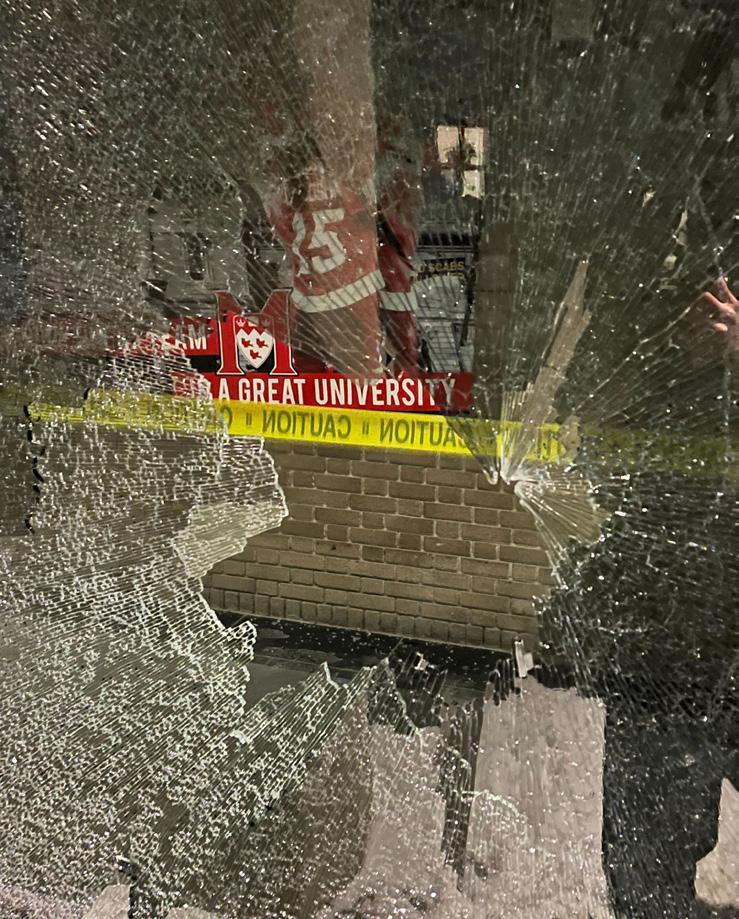
Alex was thinking more about their midterm than about the motives behind the vandalism.
“I don’t know man,” Alex said. “It’s kind of crazy that that just had to happen while writing the midterm. I was just trying to get through that, and then you hear glass smashing. You get kind of paranoid. It’s kind of crazy.”
*Alex’s name was changed to preserve their identity.
For a second time, the Board of Governors CSSR does not recommend McGill divest from weapons manufacturing Board heard reports from CSSR, Audit and Risk committees
Shani Laskin Managing Editor
The McGill Board of Governors (BoG) held its first meeting of the Winter 2025 semester on Feb. 6. The BoG—which has the final say over all academic, business, and financial affairs at the university—began after nearly two hours of private session, closed to the public and media. The meeting’s open session commenced with a report from McGill’s President and ViceChancellor Deep Saini.
Among Saini’s remarks was a reflection on the annual meeting of the World Economic Forum, which he attended in Davos, Switzerland in late January. According to Saini, the conference was dominated by conversations about AI. He noted that universities are globally seen as laggards in the AI sector.
“While we are generators of a lot of the technology that drives AI, we are almost absent from that option,” Saini said. “McGill has the opportunity to actually leapfrog and show the way.”
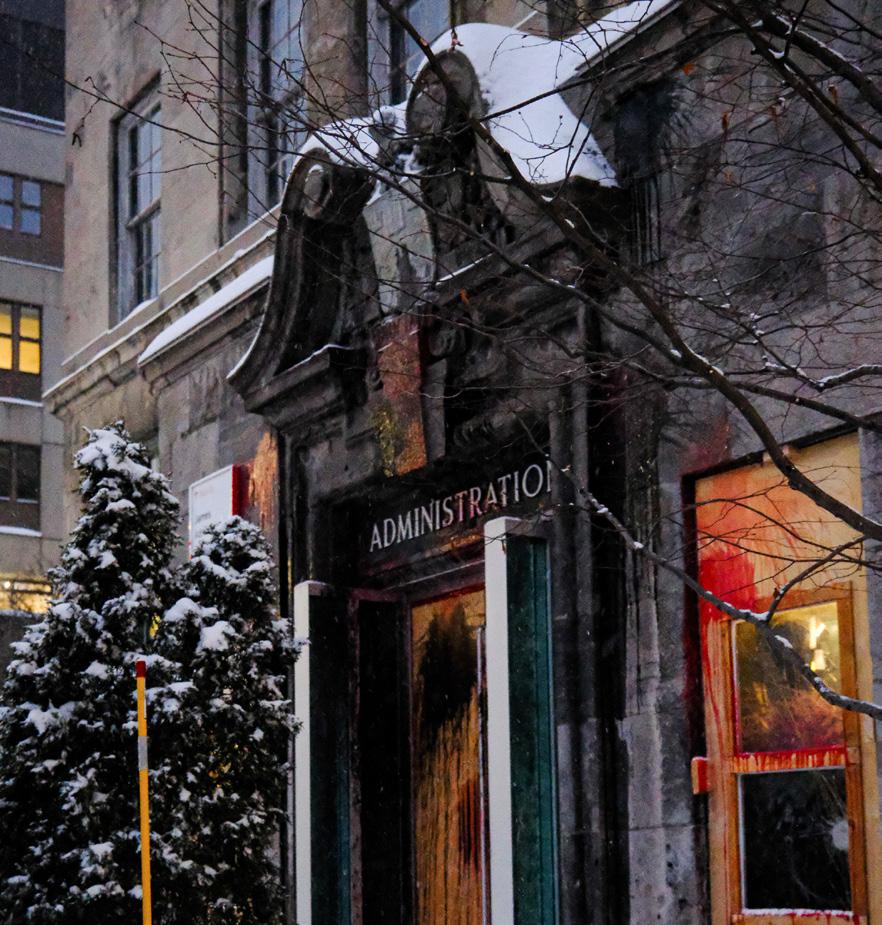
Next, the meeting moved on to committee reports, starting with the Committee on Sustainability and Social Responsibility (CSSR). On June 25, 2024, community members submitted an Expression of Concern (EoC) to the committee, urging McGill to review divestment— which was resolved in December 2024, with the BoG ultimately deciding not to divest. In its report on the matter, the committee stated that “the concept of ‘social injury’ is not one which extends a ‘daisy chain’ of causation to an infinite number of parties through their mere association or presence in a territory.”
Committee Chair Alan Desnoyers explained that during the same period, the BoG received a request from the McGill administration to explore divestment from “direct investments in companies that derive a dominant portion of their direct revenues from the production of military weapons, regardless of the country in which they operate.” The latter came from nego-
tiations between the administration and the Palestine Solidarity Encampment which took place on Lower Field for 75 days in the spring and summer of 2024, until the university dismantled it. The report shared at the Feb. 6 meeting was in regard to the administration’s request for review.
Ultimately, Desnoyers explained that the CSSR would again, not recommend divestment.
“After careful consideration of the diverse opinions and expert insights, as well as the review of McGill’s investment practices, the committee is satisfied that the university’s overall investment approach is well-positioned to preserve the capital of the McGill investment pool within the social and ethical norms of the university,” Desnoyers said.
Following Desnoyer’s presentation, Students’ Society of McGill University (SSMU) President Dymetri Taylor expressed that this decision may face backlash from students and community members and asked the Board if it would ever consider such divestment.
“I don’t think you can ever say ‘Never.’ I think it’s very context-dependent, and at this stage, [...] we felt it wasn’t necessary,” Chair of the Board, Maryse Bertrand responded.
In a written statement to The Tribune, Students for Palestine’s Honour and Resistance (SPHR) wrote that this decision will not deter their action.
“Last Thursday was a reminder to the BoG that we will not be quiet and there will be no business as usual until divestment,” SPHR wrote.
The Board then moved to hear a report from the Audit and Risk Committee. Committee Chair Maarika Paul outlined the group’s updates, including that all of the recommendations outlined in the Internal Audit Final Report of the Macdonald
Campus Asbestos Investigation have been completed. This report was submitted to the Board in September 2023 in response to multiple incidents of asbestos exposure on the satellite campus that year.
The Board then heard a presentation from Dean Viviane Yargeau on the Faculty of Engineering. Yargeau emphasized her focus on expanding experiential learning, citing the faculty’s newly-introduced Internships and Co-ops Office. The Dean also touched on gender diversity in the faculty, stating that with 36 per cent of its engineering students identifying as women, McGill has one of the highest proportions in the country.
Finally, Taylor presented on SSMU, outlining the union’s management structure, funding mechanisms, what student groups SSMU supports, and current challenges the body is facing. These challenges included polarization of the student body, a lack of engagement, and the overpowering authority of SSMU’s Board of Directors over its Legislative Council.
Moment of the meeting:
As the BoG met inside the James Administration Building, protestors splattered red paint on the outside walls of the building, materializing their discontent with McGill’s response to calls for divestment.
Soundbite:
“That’s certainly more information about the SSMU than I’ve ever had in all my years here.” — Bertrand on Taylor’s SSMU presentation.
In a town hall on McGill’s budget, executives communicated thei r plan to balance the university’s books
Daniel Miksha Staff Writer
McGill’s top executives hosted a virtual town hall on Feb. 7 to discuss the university’s 2024-2025 budget, particularly their strategy to address its deficit. Co-hosts of the event, President and Vice-Chancellor Deep Saini, Provost and Executive Vice-President (Academic) Christopher Manfredi, and Vice-President (Administration and Finance) Fabrice Labeau, laid out their plan to restore McGill’s financial stability. This is the second budget town hall McGill has hosted this academic year, with the first on Nov. 19.
Saini opened the town hall with a frank statement about the financial circumstances the university is facing.
“Our university, as we know, is facing serious financial pressures that originate from many different sources,” Saini said. “Ultimately, these pressures have significant implications for the delivery of McGill’s mission, and our identity as a worldclass university [....] Unfortunately, the road ahead will remain extremely difficult for the foreseeable future.”
McGill is currently expected to run a $15 million CAD deficit for the 2024-2025 fiscal year. This deficit would have been closer to $50 million CAD, had the university not implemented a $35 million CAD correction to its budget this past fiscal year.
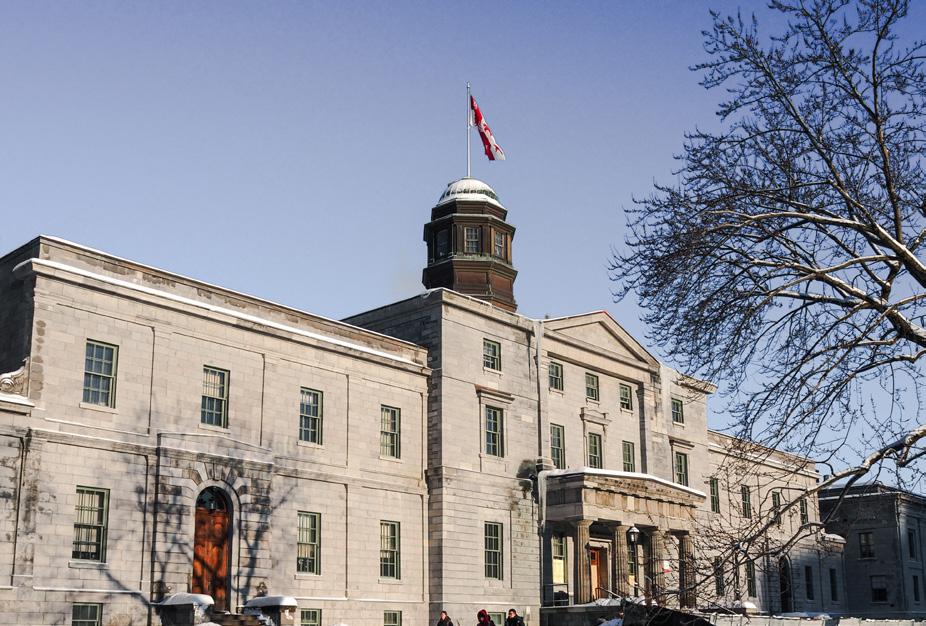
Nearly all Canadian universities are facing similar financial difficulties, as Queen’s University and the University of Waterloo face $36 and $75 million CAD deficits respectively. (Ruby Reimer / The Tribune)
To balance the university’s budget and restore its long-term financial stability, Manfredi and Labeau announced they will lead a two-phase program called ‘Horizon McGill.’ Phase one involves immediate actions to balance the 2025-2026 budget, and phase two will restructure McGill in the long-run to increase the efficiency of its operations.
A balanced 2025-2026 budget will require a $45 million CAD budget correction which would counter the budget’s expected deficit. Man-
fredi informed the community that the majority of the budget-balancing will come from reducing salary mass, requiring both academic and administrative layoffs.
“We can delay the filling of [a] select number of vacancies, eliminate overtime, reduce working hours or reduce pay where the employee is willing and where circumstances allow, and also [use] attrition, by not replacing staff who leave the university,” Manfredi stated. “But [...] that’s not likely to be enough. In some circumstances, positions will have to be abolished, resulting in the loss of employment. That’s unsettling news.”
The university has assigned individual academic and administrative units a share of the $45 million CAD correction and required them to report by early March on how they plan to implement related cuts. According to Manfredi, this will likely involve cancelling low-enrollment courses and reducing the university’s staff headcount by 250-500 people.
Manfredi identified a combination of causes for McGill’s financial struggles, including a cap on international student admissions, growing tensions between Canada and the United States, an aging population, and restrictions from the provincial government regarding the university’s use of capital funds.
Labeau explained that the university is not considering selling university lands or properties outright to combat its deficit, since such a move
would only provide short-term relief from financial hardships whose root causes can only be addressed through restructuring.
Over the next few years, the administrators explained that McGill will aim to improve operational efficiency, eliminate red tape, and join the UniForum program—a practice-sharing forum which will help McGill compare its operations to similar institutions around the world to help identify how the university can improve its financial situation through restructuring.
In a press conference following the town hall, Vice-President (Communications and Institutional Relations) Philippe Gervais told The Tribune that, though there is little students can do to add their input to the upcoming budget, they will be able to play more of a role in phase two of Horizon McGill.
“The longer project that’s going to go over two or three years, of how we’ll restructure, and where I think a lot of the fundamental decisions will be made, [will have] plenty of room for consultation,” Gervais said.
Though Saini stressed that the coming years will be difficult and result in a compression of the university, he expressed that cuts need to be viewed in the context of the university’s long-term objectives.
“Ultimately,” Saini said, “we want to emerge as a stronger McGill, a McGill that is more resilient, a McGill that’s more sustainable, and a McGill that, frankly, is more impactful on a global stage.”
The Tribune Explains: The BSN’s fund for Black, African and Caribbean students and organizations
The fund aims to support Black identifying-students and organiza tions on campus
Malika Logossou Student Life Editor
On Jan. 6, McGill’s Black Students’ Network (BSN) launched the Black, African and Caribbean Students and Organizations (BACSO) pilot project. This project seeks to provide funding for Black, African, and Caribbean Students at both the undergraduate and graduate levels, as well as Black organizations at the undergraduate level. The BSN has set aside $30,000 CAD for this initiative and will split the funds equally between student and organization applicants under the Students’ Society of McGill University (SSMU). The Tribune explains the ins and outs of the fund and how students can access it.
Why did the BSN create this fund?
The BSN’s VP Finance Orlane Donkpêgan, U3 Arts, explained that this initiative was made possible after SSMU members voted to approve a service fee increase for the group during the 2024 Winter Referendum. This doubled BSN’s service fee from $1.00 CAD to $2.00 CAD per student per semester.
Donkpêgan expressed that with an expanded budget, the BSN was able to improve its financial management from previous years and provide direct support to Black-identifying students and Black student-led organizations at McGill through initiatives like BACSO.
“The necessity of this fund was mostly
to give back to Black organizations and the Black community,” Donkpêgan told The Tribune. “Because we operate as a service, I felt like one way to support our community better was to give back financially. [We are doing] so by supporting clubs that might be lacking funding for a specific event, or for students facing significant, difficult hardships preventing them from meeting essential needs.”
How does the BSN allocate funding?
BACSO provides the funds in two ways.
The Financial Support for Black, African and Caribbean Students fund (FS for BACS) has not been launched yet but will aim to offer monetary support to individuals. Students can split their financial requests over multiple months within a semester, but the total amount they request cannot exceed $1,500 CAD per semester. Donkpêgan reported that the BSN prioritizes first-time applicants and requests related to education and health expenses, although FS for BACS can also support Blackidentifying students who want to launch specific initiatives or projects.
The Financial Support for Black, African and Caribbean Organizations fund (FS for BACO), on the other hand, supports SSMU-affiliated Black organizations with bank accounts operating under the student union. These organizations can apply for up to 45 per cent of the fund’s allocation, or a maximum of $6,750 CAD, to support club events.
How does the application process for fund-
ing work?
Students and organizations must fill out unique application forms detailing the amount they are requesting and their intended use of the funds. The BSN President, Finance Project Manager, and VP Finance review these applications on the 15th and 30th of each month. The network reserves the right to request additional documents from the applicants and SSMU throughout the review process. They may also consult SSMU’s Black Affairs Office before making final decisions; otherwise, all applications are kept confidential. According to Donkpêgan, this process is rigorous but necessary for the BSN.
“The application process is tedious. The questions are usually long and we look at them very carefully. We want to make sure people are putting care in their application, in the same way, we want to take care in helping students and making sure we make meaningful change in our community,” Donkpêgan explained.

the BSN has ever launched for students and organizations.
How does the BSN hope to continue the pilot project?
Donkpêgan stressed the importance of ensuring this initiative creates a lasting foundation for future BSN projects. Although a pilot project, BACSO may grow and evolve in the coming years. This is the first fund that
“It was very important to me that we establish this project before I leave McGill,” she shared. “$30,000 [CAD]is a considerable amount of our budget, but we think this is a way of helping our community. [....] With tuition being a lot more expensive and the cost of living increasing, especially for visible minorities, this fund helps alleviate some of that added stress, on top of the pressures BIPOC students already face.”
Amelia H. Clark Staff Writer
The Students’ Society of McGill University (SSMU)’s Feb. 4 Board of Directors (BoD) meeting saw the ratification of the Motion Regarding SSMU Building Gender Neutral Washrooms, renamed to the Motion Regarding SSMU Building Universally Accessible Gender Neutral Washrooms. This follows the Board’s delay of the motion’s ratification at Jan. 7 and Jan. 28 meetings.
The motion—put forward by Vice-President (VP) University Affairs Abe Berglas—mandates that SSMU implement gender-neutral washrooms in the University Centre, which currently only con-
tains three single-use gender-neutral stalls.
First, the BoD unanimously voted to declassify the discussion of the motion, allowing nonmembers to remain present during the debate.
Member-at-Large Dylan Seiler requested that the motion be included in the next SSMU Referendum ballot and—if passed by the student body— be ratified by the Board.
Berglas responded that this would further delay the motion, emphasizing that transgender and non-binary people’s accessibility to a washroom should not be a matter of debate.
“If people have concerns about genderneutral bathrooms, oftentimes that comes in the form of not wanting to be in the same bathroom as a trans person, and I don’t think that we should consider that as a reasonable argument,” Berglas said. “I am interested to know whether the concerns from constituents might be transphobic rhetoric, and so we should not heed them as proper concerns, but we should shut them down for what they are, which is hate speech.”
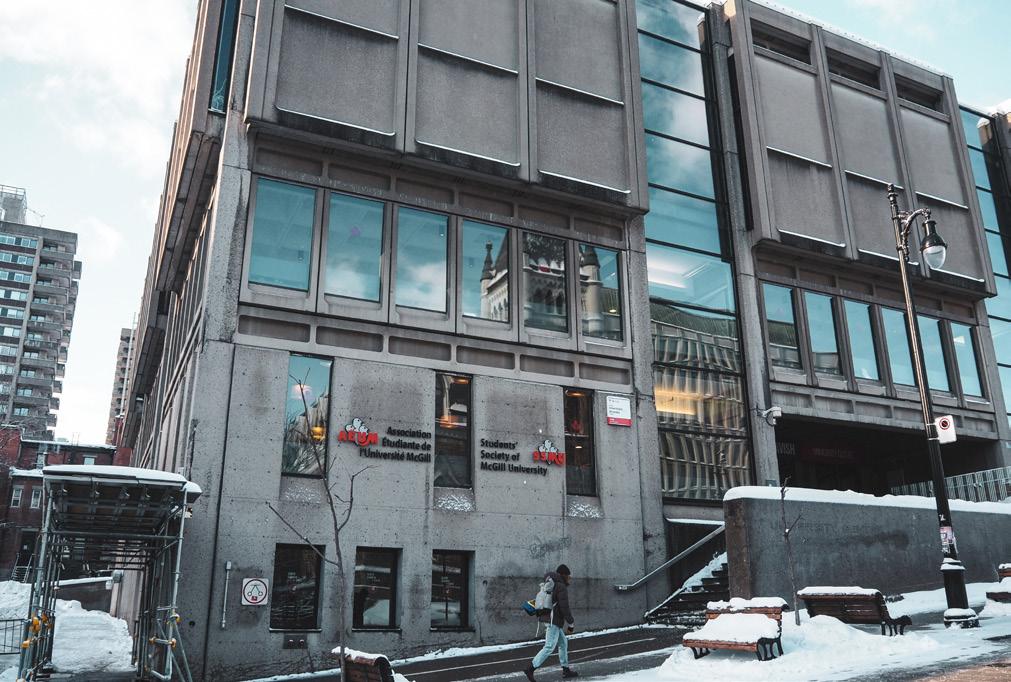
The BoD approved the Motion Regarding the Approval of a Referendum Question Amending Section 1.3 of the SSMU Constitution. Students will vote on turning the constitution’s preamble into a “mission” rather than a mandate in Fall 2025 Referendum. (Ruby Reimer / The Tribune)
VP Internal Zeena Zahidah seconded this point, stating that the motion is an opportunity to not only make bathrooms accessible for all gender identities, but also disabled people.
“It helps everybody. It doesn’t hurt anybody,” Zahi-
dah said. “We cannot rely on the majority of students to vote to protect a minority.”
Arts Representative Rishi Kalaga countered Zahidah’s point, arguing that while the motion is up to interpretation, no part stipulates that genderneutral bathrooms address ability concerns. Like Seiler, Kalaga recommended putting the motion on the Referendum ballot.
“The biggest responsibility is to make sure we’re actually representing the student population which we’re purported to represent,” Kalaga said.
The motion to place the issue on the Referendum ballot failed with two votes in favour, six opposed, and one abstaining. When put to a vote, the Board ratified the motion after modifying it to explicitly include accessibility goals. The final vote was eight in favour and one against—Kalaga.
Member-at-Large and Arts Undergraduate Society (AUS) President Sophia Garofalo brought forward two motions, both standing to address concerns about the Involvement Restriction Policy (IRP) List.
The first was a Motion to mandate the SSMU Human Resources (HR) Manager provide the IRP list to faculty equity commissioners. This list names McGill students who, due to criminal accusations or charges, cannot participate in campus events, and is to be shared with each faculty’s equity commissioners. However, Garofalo reported that SSMU’s HR had failed to share the list with equity commissioners this year. As a result, the commissioners cannot consult the list in their hiring and inviting processes when organizing events.
The second was the Motion to mandate the HR Manager to review ongoing assault cases to
identify any delays in action. Garofalo explained that survivors of sexual assault have come forward reporting that they have witnessed their assaulters both attending and managing SSMU-run social events. She noted that some survivors have come forward as early as September requesting that their assaulters be put on the IRP list, but received no response from SSMU.
The motion was approved unanimously, putting forth a mandate that HR must share the list with equity commissioners on a regular basis. It also states that candidates must be screened through the IRP list before hiring, and that reports made to HR alleging assault, and recommending placement on the list, be addressed by March 14.
Moment of the Meeting:
The BoD approved the Motion to Approve the Budget for 2025 Faculty Olympics, an interfaculty competition inviting students to participate in sport, academic, and social challenges.
Soundbite:
“This is the correct step, and a belated step following previous advocacy efforts in the past. I think if we do any further delay, the people who motion to do the delay might do themselves the disservice of standing on the wrong side of progress.” — SSMU VP External Affairs Hugo-Victor Solomon on the Motion Regarding SSMU Building Universally Accessible Gender Neutral Washrooms.
New thrift store seeks to reduce waste and improve sustainabili ty at McGill
Amelia H. Clark Staff Writer
In February, the Student Life and Learning and Student Housing and Hospitality Services celebrated three months since the opening of Thrift McGill, which was established with funding from the Sustainability Projects Fund (SPF). The store, located at 3473 Rue University, seeks to promote more sustainable shopping on campus by facilitating a way to reuse secondhand items.
Daniel Fournier, Associate Director of Residence Life, explained that Thrift McGill aims to reduce campus wastefulness through a “circular economy.” Fournier noted that wastefulness is particularly prominent in residences and in Milton-Parc, the popular student neighbourhood, where useful items get disposed of every year when students change housing arrangements.
“At its core, Thrift McGill promotes a circular economy, which means keeping items in use for as long as possible instead of sending them to landfills,” Fournier wrote to The Tribune. “A free store felt like the perfect solution to help address both issues: reducing waste while making quality items accessible to students.”
Fournier believes that Thrift McGill helps address socioeconomic barriers by providing access to essentials, like winter attire, for free. Fournier stated that this speaks to
the store’s circular economy because, once the weather becomes warmer, those who took winter clothing can re-donate them.
“Our goal is to build a self-sustaining ecosystem where items circulate within the McGill community while also ensuring that any surplus is donated to local charities and thrift stores in Montreal,” Fournier wrote. “This way, nothing goes to waste, and we continue to extend the life cycle of everyday items in meaningful ways.”
Since its opening, Fournier stated that Thrift McGill has received over 1,600 donations from the McGill community and hundreds of visits from faculty and students alike last semester. Thrift McGill’s popularity has even led to a logistical issue, as the shop has received so many donations that they could not accept them all.
Nami Dwyer, U0 Science, has visited Thrift McGill on multiple occasions, and she believes that the store is conducive to more sustainable practices.
“I think [Thrift McGill] is a really good way for McGill to be sustainable because it really makes people aware when they come here. At the same time, it also supports the environment,” Dwyer said in an interview with The Tribune
However, Dwyer noticed that McGill’s commitments to sustainability were also lacking in other areas.
“I’ve never really seen compost bins
around campus,” Dwyer said. “In library areas, I only see recycling and garbage. I feel like it would be good to spread more awareness on that.”
As part of McGill’s ZeroWaste initiative by 2035, they intend to expand compost collection to all residences and to over 25 academic buildings. Currently, the administration has implemented pilot locations to ascertain how successful composting is.
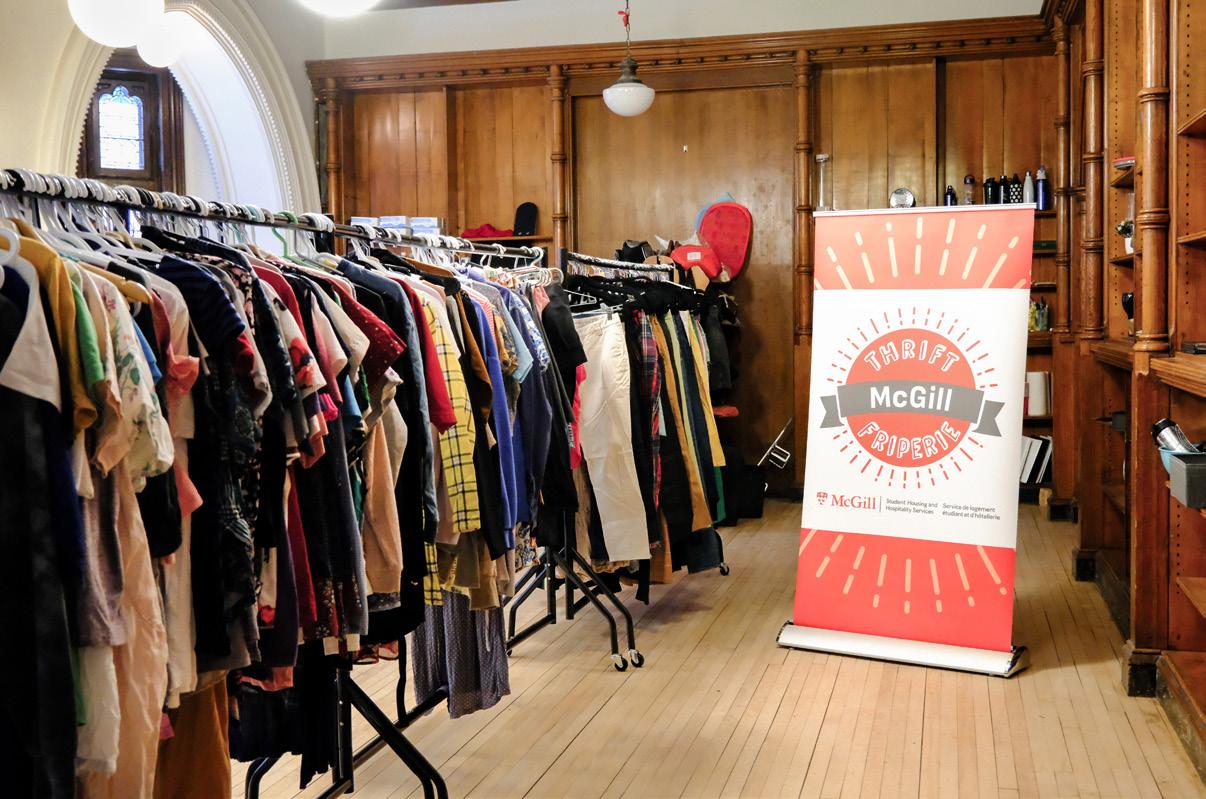
The Sustainability Projects Fund offers five paths for funding, ranging from under $300 CAD to over $100,000 CAD. (Hannah Nobile / The Tribune)
munity. The project has clear environmental, economic, and social benefits for everyone involved,” Watt wrote.
In an email to The Tribune, Shona Watt, Associate Director of the McGill Office of Sustainability, wrote that she believes the McGill community will see more environmentally-focused initiatives in the coming years. In this academic year alone, 18 projects were approved or were in the process of being approved, ranging from community garden expansions to activism panels.
“We are thrilled that Thrift McGill is open and already loved and used by the com-
For Fournier, expanding Thrift McGill’s services is crucial to better accommodate whatever the McGill community may need.
“Our long-term vision is to expand Thrift McGill into a permanent, full-time fixture on campus,” Fournier wrote. “We’re also looking into collaborating with other sustainability-focused groups at McGill and possibly introducing seasonal pop-up shops, themed donation drives, and Residence Life programming to enhance the store experience.”
Editor-in-Chief
Jasjot Grewal editor@thetribune.ca
Creative Director Drea Garcia Avila dgarciaavila@thetribune.ca
Managing Editors
Yusur Al-Sharqi yal-sharqi@thetribune.ca
Shani Laskin slaskin@thetribune.ca
Ella Paulin epaulin@thetribune.ca
News Editors Eliza Lee
Kaitlyn Schramm Mairin Burke news@thetribune.ca
Opinion Editors Ellen Lurie Lulu Calame Monique Kasonga opinion@thetribune.ca
Science & Technology Editors
Coco Zhang Leanne Cherry scitech@thetribune.ca
Student Life Editors Auxane Bussac Malika Logossou studentlife@thetribune.ca
Features Editor Amalia Mairet features@thetribune.ca
Arts & Entertainment Editors Kellie Elrick Charlotte Hayes arts@thetribune.ca
Sports Editors Anoushka Oke Clara Smyrski sports@thetribune.ca
Design Editors Mia Helfrich Zoe Lee design@thetribune.ca
Photo Editor Hannah Nobile photo@thetribune.ca
Multimedia Editor Sahel Delafoulhouse multimedia@thetribune.ca
Web Developer Laura Pantaleon Roberta Du webdev@thetribune.ca
Copy Editor Matt Adelberg copy@thetribune.ca
Social Media Editor Aliya Singh socialmedia@thetribune.ca
Business Manager Celine Li business@thetribune.ca
Following Prime Minister Justin Trudeau’s resignation announcement last month, he leaves behind a 10-year-long legacy of landmark initiatives founded in his majority Liberal government, including the establishment of the Parliamentary Black Caucus (PBC) and the Liberal Black Caucus (LBC). The past decade has been shaped by both progress and challenges for Black communities in Canada, and now, with an election looming, the future of Black political leadership faces a critical juncture. This transformation could redirect the momentum, stability, and visibility of Black political representation—and therefore of justice—for Canada’s Black communities.
Though symbolically monumental for the support and endorsement of Black politicians, the PBC and LBC have struggled to concretely establish themselves in public discourse, lacking a firm foundation from which to demand actionable steps towards Black representation and addressing antiBlack racism. PBC is notably absent from social media, and LBC has only a small following. Neither group has made a major public statement since that of the PBC in 2020, when the


caucus commented on the growing Black Lives Matter movement. Of the 40 actionable steps laid out in this public statement—which included disaggregated data collection, financial assistance for Black businesses, and the implementation of a Black justice policy strategy—only 24 have been addressed. However, the majority of these actions are merely proposed bills or, for those that have been passed, are still in the budgeting phase.
Gaining respect and consideration as a Black politician means riding a fine line between palatability and protest. For example, in October 2023, the Ontario New Democratic Party expelled Sara Jama from its caucus after she expressed support for Palestine. When faced with such severe scrutiny and backlash, racialized politicians often face the difficult task of balancing political survival with staying true to the communities they represent. Efforts to appear more acceptable within the political system may be strategically effective, but they pose the risk of Black politicians being perceived as allegiant to a system that has long oppressed and marginalized Black communities.
However, it is Black political representation—especially the inclusion of Black women— which has fueled some of the most



Auxane Bussac Student Life Editor
Afew weeks ago, my friend Toscane and I were stopped by a man who asked us if we were French. With our affirmative response, he excitedly expressed his love for our accent before noticing the Hamsa pendant on my necklace. Also called the Hand of Fatima, the Hamsa symbol is popular in North Africa where it is believed to ward off evil and bad luck. The man then asked me: “Are you Moroccan?” When I answered that my mom was, his face lit up, and he started speaking to us in Arabic.
crucial advances in anti-racism in Canada. In February of last year, a group of Quebecois Black political leaders established Montreal’s first Black women’s caucus—a vital step in platforming the uniquely marginalized voices of Black women in government. Solidifying and upholding this Black representation, however, requires consistent investment in financial resources, mentorship, media coverage, and institutional support in every echelon of Canadian society—from elementary school classrooms, to university hiring practices and academic Black studies programs, to political internship opportunities, to the highest levels of government.
As Conservative party leader Pierre Poilievre—a candidate explicitly opposed to Diversity, Equity, and Inclusion (DEI) initiatives—leads in the polls for the October federal election, it is ever more important that the foundations of Black political representation and funding for DEI initiatives under the Trudeau government are not abandoned, but rather reinvigorated. But the effort to maintain this energy cannot fall solely on the shoulders of Canada’s Black communities.
When they bear the full weight of this effort, non-Black people evade accountability for their own role in a racist system, and the contributions of

Black politicians’ are often reduced to their racial identity, dismissing their expertise beyond racial issues.
Politicians must prioritize policy changes that address racially oppressive legislation over glamorous self-centred political action, while the broader government’s data collection must be disaggregated to make visible the violence and marginalization faced by Canada’s Black and racialized communities.
In a moment when Black political representation is already limited, the most important commitment is that of sustained mobilization against anti-Black racism and the barriers to representation. When so many forces are pushing against this movement, students must look to the past to remind themselves that collective conviction has the power to reverse even the most disheartening tides. As students whose activism has achieved revolutionary change in the past, McGillians must harness the malleability of this moment as a window for monumental progress garnered through persistent education, protest, and confrontations both small and large. Expanding and strengthening Black political representation is the only means by which Canada can fight the tide of racism, white supremacy, and Black erasure propagated by an already white-dominated political system.



I apologized and politely explained that I unfortunately didn’t speak the language—and his disappointment was obvious.
I am all too familiar with this kind of situation. I feel proud when people ask if I am Moroccan, but that feeling quickly fades when I cannot interact with them in the language. The shame I feel in those moments makes me wonder if it’s even fair to mention that I have some Moroccan blood.
My mom was born and mostly raised in Rabat. From her name and her looks, you can immediately tell that she’s from North Africa. I, however, inherited my last name from my French father, meaning that, on paper, my tie to Morocco is mostly invisible. My name is Auxane Nawel Bussac, but my Arabic middle name exists only on my passport; even my McGill ID does not show it. At times, I have been called “white-passing” because, despite my curly hair, you wouldn’t assume that I am anything other than French—my little brother took all the Moroccan genes.
Some part of me has always
been frustrated that I cannot prove my heritage without showing a picture of my mother’s side of the family. Only the oldest four of my 14 cousins got to spend their summers at my grandparents’ house in Rabat, learning about Moroccan culture and their roots; The rest of us didn’t have that opportunity. I have visited my grandparents many times, but only ever briefly, spending most of our time in the house speaking French, and never getting the chance to interact with anyone in Arabic.
Compared to my aunts and uncles who actively practice their heritage, my mom barely identifies with Morocco. She went to a French high school while living in Rabat, then left the country when she was 18, and rarely speaks Arabic anymore. While raising my brother and me, however, she did occasionally throw in some words of Arabic, especially when she was mad. Every one of those moments reminded us of our mother’s Arabic past. One that was only hers, and couldn’t be ours. She was never very open to talking about that side of her, widening the gap between
her culture and my brother and me. I don’t speak Arabic. My brother and I have both tried to learn, but never with any consistency. But that does not mean I can’t relate to my Arab heritage. I might not be Moroccan, but my mom is, and I firmly believe that this in itself is a core part of my identity as well. When I find myself in a situation where people are disappointed that I don’t know Arabic, I remember that I watched the 2018 World Cup Final in a Moroccan lounge at a distant aunt’s place in Rabat. That specific moment, and all the others that I spent with the Moroccan side of my family, are proof that I do belong, whether or not I speak Arabic I am not Moroccan, but I am not not Moroccan either. I don’t mind standing in the middle. This blend might even be a gift, a sign from my middle name Nawel, which means “gift” or “unmerited favour of God.” One day, I’d love to learn Arabic—but until then, if asked about my origins, I will proudly say that I am part Moroccan, on my mom’s side, without feeling ashamed.
Millen Yemane Contributor
The intersection of language and politics has long been a source of contention in Quebec, with the call to “protect the French language” often presented as a sort of political imperative. In spite of the steady growth of Quebec’s total francophone population, concerns of French’s supposed decline have intensified in recent years. In a province where French is so highly revered as a core aspect of its identity, the measures taken to preserve French walk a fine line between preservation and division—a line the government recently loitered after spending nearly a quarter of a million dollars to monitor French in Quebec’s businesses and shops.
In 2022, the Quebec government hired a private research firm to make sure businesses were greeting customers in French. To test this, the firm conducted an eight-month long study that involved sending members into businesses to impersonate customers and receive typical service. The pseudo-customer would then take notes on the greeting received—in terms of the language used and proficiency of language— and record their observations via. electronic questionnaire, submitting the data to the OQLF. This process was repeated in over 3,000 businesses in Montreal, setting the OQLF back approximately $224,000 CAD.
The results of this study found that 71 per cent of greetings were exclusively in French, while 97.4 per cent of businesses had French services available. While these percentages seem like clear evidence of a thriving French language, the Office québécois de la langue française (OQLF) felt the opposite, claiming that it proved French was on the decline. All because, despite the overwhelming availability
COMICS design@thetribune.ca
of French, the percentage of French-only greetings had gone down by less than four per cent.
Jean-Francois Roberge, the Minister responsible for the OQLF, issued a statement on the study, remarking that the decrease in French-exclusive greetings indicates that French is becoming less prevalent in Quebec’s public sphere.
This approach is both antagonistic and counterfactual to the strong pervasiveness of French in Quebec. We should be celebrating the fact that French is alive and well in Montreal instead of framing the study as a sign of linguistic erosion. As a matter of fact, there’s been a steady increase in the availability of services in French since 2010. The strange interpretation of these results raises the question of what political motivations might underlie such a negative analysis of a seemingly positive result.
Cherry-picking the one ‘bad’ result and ignoring the positive findings of the study is an inherently dishonest practice, using research for political aims at the detriment of harmony between Quebec’s anglophone and francophone communities. The OQLF’s budget should be used to promote French constructively rather than as a tool for political messaging.
Language discourse aside, the matter of spying on businesses without their informed consent is a further argument for the inappropriate implementation of this study. Not only is it invasive (and rather unsettling), but it walks a fine moral line in terms of basic research ethics. Undercover agents disguised as customers to wander into predetermined addresses and secretly record conversations pushes the boundaries of the American Sociological Association’s Code
by Ryan Dvorak

of Ethics in sociological research. Not to mention, discovering that your government is collecting data on you without your knowledge undermines public trust in such institutions and creates an atmosphere of opposition instead of solidarity. No one likes the idea of being watched, especially not covertly by their own government using public funds. If the publication of this study does end up leading to an increase in French greetings, it would be through Orwellian-adjacent surveillance tactics.
This is not to say the French language should not be protected. French is a core aspect of Quebec’s history and provincial identity. With that being said, studies like these do
little to incentivize the long-term protection of the language. Perhaps more anglophones will greet customers with Bonjour if they think they’re being watched, but this shift would likely be confined to the business setting, and not something socially internalized through effective promotion and a sense of provincial identity. Why would you want to dedicate months of study to a language being forcibly shoved down your throat through coercive measures? The so-called “promotion” of French creates an environment less conducive to longterm social acceptance of French and instead establishes a hostile relationship between the Quebec government and the people whose language habits it is trying too hard to control.

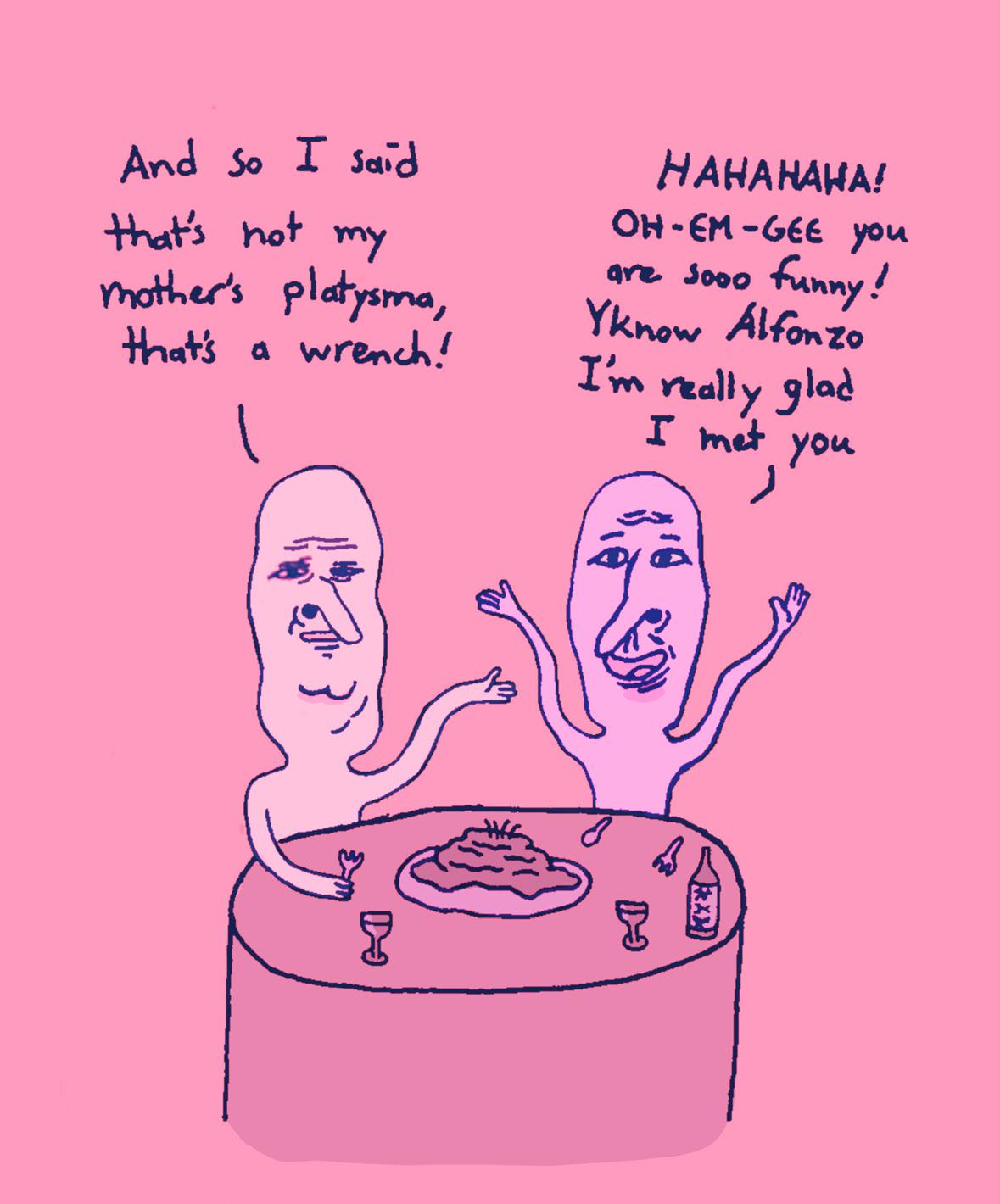

Gentle love is not a weakness (despite what media may have you
However, some recent shōjo seasons released this month serve as perfect arguments to the contrary.
love are those which precede the first text, the first date, the first kiss. The first butterflies, the first blush, the first compliment that has you kicking your feet in bed. These moments tend to be insignificant in romance media, eclipsed by the overwhelmingness of all that comes after. Compounded with the emerging trend of “nonchalant” romance, where emotional expression is often downplayed, these elusive moments appear even less. Even valiant efforts to prevent women characters from having overly man-centric ambitions can be misconstrued as devaluing a desire for love—all of which nudges these moments further from the spotlight.
Unless you are an avid fan, you probably associate anime with one of two things: “That white-haired dude” or cartoons. In reality, anime is a diverse selection of media that displays dedication, artistry, and novel ideas. Often the shows are defined by the intended audience, rather than by genre. One example is shōjo anime, targeted towards adolescent and young adult women, and often characterized by its focus on love: Both platonic and romantic. Although there can be a non-romantic complimentary plot, the spotlight remains on the minutiae of the relationships between characters. Because of this, the genre is often written off as frivolous or insignificant, overshadowed by the popularity of shōnen, which targets young men with traditional hero’s journey narratives.
Season 2 of Apothecary Diaries started airing on Jan. 10. It follows the adventures of Maomao, the poison taster of the rear palace around 15th-century China. Her sharp wit and adept curiosity allow her to discover threats before they come to fruition. In a subversion of traditional gender roles, she is both oblivious and indifferent in the face of romance, seeing everything through a logical and tactical lens. In contrast, one of the head administrators, Jinshi, is expressive and emotional such that everyone in the palace knows of his admiration for her, except Maomao herself.
In typical shōjo fashion, the show highlights the part of relationships that are never really featured in mainstream romance: The simple development of affinity towards someone. There are numerous interactions that precede flirting: Flickering moments of romance—inconsequential conversations of Maomao eagerly explaining an apothecary principle to Jinshi, who listens in fascination, entranced by her passion—become all the more potent. It would be easy to write it off as boring if you overlook the importance of these moments; there’s something inexplicably sweet about a human investing themselves in the interests of another. That is the magic of shōjo: It portrays the menial and unnoticed, within which the sweetest aspects of human affection are hidden.
Similarly, Honey Lemon Soda, which began streaming on Jan. 8, offers another example of the beauty of shōjo. This anime features the


Since 1950, the emergence of women artists and the development of roma-kome manga allowed the shōjo genre to gain traction. (Mia Helfrich / The Tribune )
classic high school setting, and follows a sliceof-life style plot; nothing extravagant happens beyond the everyday interactions in school life.
The protagonist is Ishimori Uka, a shy girl who is so desensitized to bullying that all she wishes to do is remain “still as a stone.” At her new high school, she hopes things will be different but believes she doesn’t deserve much kindness.
Miura Kai is the sleepy, carefree popular boy in her class, who takes it upon himself to help her become the person she most wants to be. His advice to her is clear: “Ask someone for help.”
The common response would have been to
‘toughen up’ and find a way to deal with it on her own; instead, she remains her wonderfully shy self and gradually works towards her goal of finding her voice, even when she believes she doesn’t deserve it. This alternative characterization is a reminder that kindness, insecurity and reliance on another is equally brave.
Shōjo anime deserves all the respect for giving attention to the aspects of humanity that we deem weak and insignificant. It is a reminder that to show care for another is one of the scariest, strongest, and most human things you can ever do.
McGill Classics Department wields love to explore Medea’s story in ‘The Argonautica’
Foulds and O’Keeffe present a shift in perspective on the actions of an infamous character
Norah Adams
Contributor
The ancient Greek figure of Medea likely makes your skin crawl with discomfort—or maybe causes you to shiver with morbid curiosity. For how could a woman, scorned nevertheless, be pushed to the extreme of killing her own children?
Euripides’ play, Medea, features such a story, where the titular character’s heartbreak results in filicide, a starkly violent and unthinkable act. With these grim expectations, when the McGill Classics Department’s rendition of the same character’s story begins, I am surprised to be met with a tale focused more on the complexities of love than murder.
Throughout the play, Jason’s Argonauts share an easy camaraderie. They roughhouse, hug—and most importantly, sing sea shanties—all like an affectionate, albeit slightly rag-tag, family. Medea, an often villainized character, is provided space through which she demonstrates how much she cares for the important people in her life, such as her sister, Chalciope (Azmi Rizwan Aandi) and even her viciously strict father, Aeetes (Vincent Carrier).
These familial feelings are not just present amid the writing of the adaptation by Carys Foulds and Jericho O’Keeffe, but within the cast and crew as a whole.
“We tried to foster an environment where
it felt a lot more collaborative,” O’Keeffe said in an interview with The Tribune
From scene to scene, an atmosphere of synergistic energy is unmistakable. The actors on stage seem to be genuinely having a blast. Each moment of banter traded between crewmates reads utterly believable as the actual companionships of the cast members shine through.
As I watch the play, I can’t help but feel that I am watching one big, theatrically imbued hangout between friends.
Love stands at the forefront of the show, from Mopsus’s (Laura D’Angelo, Arts) prophetic relationship with their bird to the two stars’—Young Medea (Siobhan Wright) and Jason (Marissa Miller Sommer)—budding romance. I was stirred to wonder what led the directors to shift from the clash of swords to the quiet weight of longing and loss. Why they chose to let Medea’s story take precedence, while Jason’s remained in the background: Was it simply a change in perspective or a radical feminist retelling?
The directors/adapters of the play shed light on the prevalence of undervalued and even misrepresented women characters in ancient Greek literature. One such character is Penelope from Homer’s Odyssey, who governed Ithaca for 20 years while waiting for Odysseus to stop getting blown off course and return home. In developing their version of The Argonautica, it was essential to O’Keeffe and
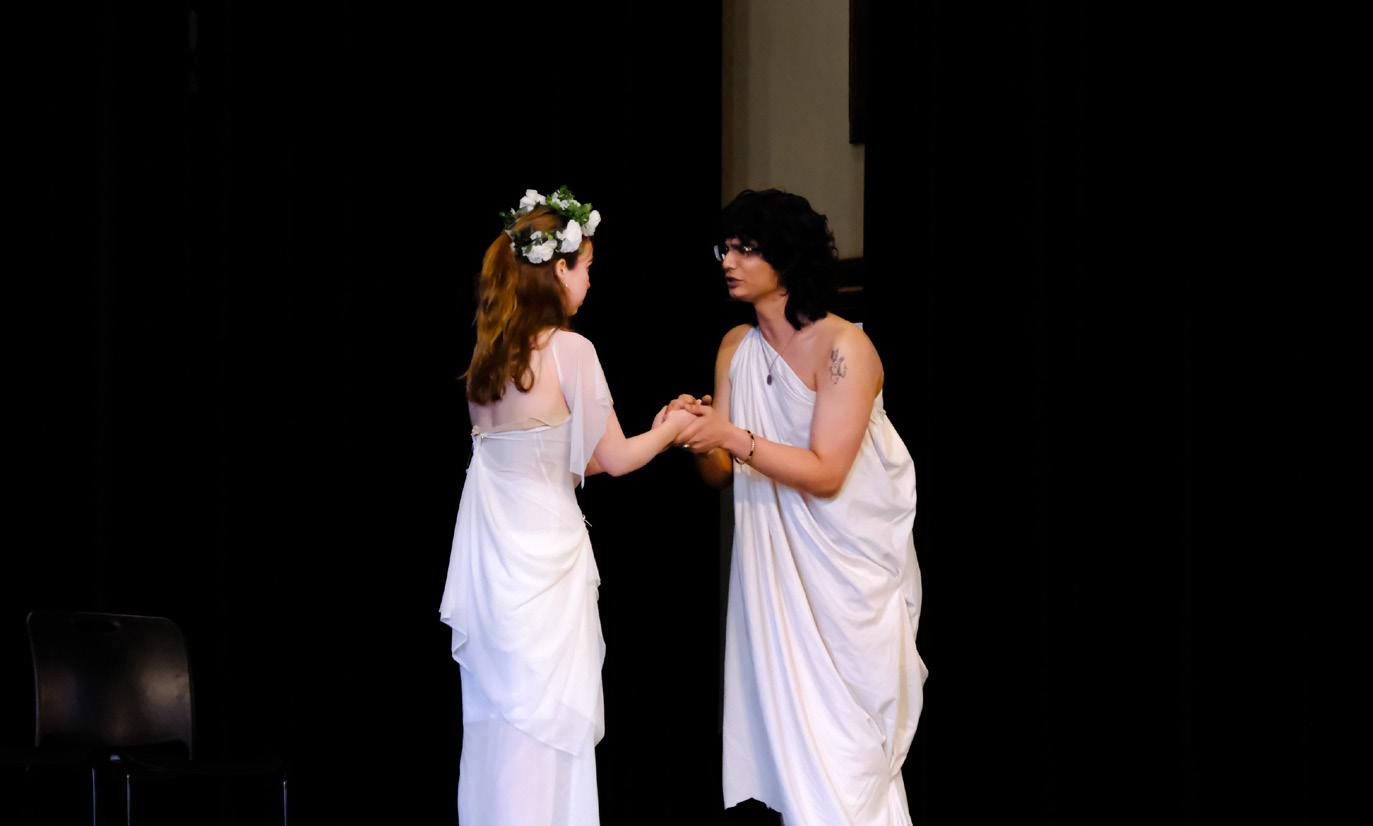
The show features a handmade dragon puppet large enough to require two puppet masters. (Hannah Nobile / The Tribune)
Foulds that they offered Medea the opportunity to tell her own story of how she ended up in such a brutal place.
The play is ultimately successful in attending to women’s often unnoticed but essential role in driving men forward in Greek epics. In Apollonius of Rhode’s depiction of Medea’s character, Hera divinely forces her to help Jason by making her fall in love with him.
This is not the Medea onstage at Mainline Theatre. Armed with autonomy, she herself decides to help the hero, and only because of a wish to aid Chalciope; it is a strong sisterly
relationship that leads her to take action. The production also removed a majority of violence from the story, the most notable missing piece being Medea’s murder of her children. The show instead ends with the woman getting the final word before walking off, finally able to tell the tale herself.
From translating an Ancient Greek epic to turning up the lights on show night, this play is Carys Foulds and Jericho O’Keeffe’s child. And like Medea, they killed it!
The Argonautica played from Feb. 5-8 at Mainline Theatre.

On Jan. 13, 2025, Mali took a bold step in reclaiming control over its natural resources, as the government began seizing $245 million CAD worth of gold stocks from Canadian mining giant Barrick Gold. The seizure is part of a wider dispute over Barrick’s refusal to pay its dues under Mali’s newly passed mining codes, which seek to address decades of unequal agreements that have left African states with minimal stakes in their own resources. A quick search reveals that this is not the first time Barrick has been called out—among other controversies, Mali had previously demanded about $500 million USD in unpaid taxes from Barrick, a sum that points to the company’s failure to meet its obligations.
This issue stretches far beyond Mali and forms part of a larger, predatory pattern. Nearly half of the world’s mining companies are based in Canada, and they are leaving a trail of devastation.
In Ecuador, Indigenous women have been sounding the alarm that a proposed free trade agreement between the Canadian and Ecuadorian governments could pave the way for even more human rights and environmental abuses by Canadian mining companies.
In Honduras, two workers fled their village after forces tied to the now-closed Canadian mining giant Gold Corp murdered their uncle, an environmental activist, in what they believed was a targeted killing.
When they sought refuge in Canada, officials told them to lie about their story and present it as an escape from drug traffickers instead of revealing the truth—that their uncle’s death was a direct consequence of Canada’s mining interests. These are just two of countless examples of how Canada’s global footprint is built on exploitation, all while the country turns a blind eye to the damage caused in its name.
Even within Canada, the government has allowed corporations to exploit the country’s land and mistreat its Indigenous communities. This is especially troubling because the mining industry does have the potential to be more ethical through measures like sustainable resource management, community engagement, and stringent environmental protections. Our dependence on mining industries, particularly for technology, is undeniably problematic.
However, change is possible even within our global capitalist economy. Ethical mining must address historical injustices by securing community consent, investing in longterm benefits for local populations, and en-
suring transparency in supply chains. While the extractive industry has caused significant harm, it’s possible to envision a future where it is compatible with both environmental and social well-being. The challenge lies in shifting the focus away from corporate interests and toward a model that prioritizes people and the planet.
The mining giant Glencore stands in stark contrast to this vision of ethical mining. After years of investigations, the Swiss Office of the Attorney General found the company guilty of “inadequate organization” due to corrupt mining deals in the Democratic Republic of the Congo, specifically around its dealings with Israeli businessman Dan Gertler. Glencore’s involvement in bribery and illegal practices resulted in significant losses for the Congolese people, with billions of dollars in potential earnings from resources like copper and cobalt being siphoned off. Glencore has paid fines, but the penalty barely scratches the surface compared to the wealth generated by exploiting these resources. Even after the United States government sanctioned Gertler for his role in this corruption, Glencore continues to pay him tens of thousands of dollars as royalty payments from mines acquired through these corrupt deals. Undeterred by these controversies, Glencore is expanding its operations in Canada, acquiring four massive coal mines in British Columbia. Glencore’s takeover of B.C. mines raises concerns about ongoing selenium pollution in the Elk River Valley, which has long been toxic to fish. Reports highlight that the government has failed to impose strong conditions on Glencore to halt the pollution and cover the massive cleanup costs. Advocates fear the company’s vague commitments to environmental remediation will fall far short of addressing the long-term environmental devastation in B.C.
Canadian mining companies dominate the global extractive industry not because of their technical expertise or ethical leadership, but because Canada has deliberately positioned itself as a regulatory bastion for mining corporations. With 47 per cent of the world’s public mining companies listed on Canadian stock exchanges, the country provides an ultra-permissive legal, financial, and diplomatic environment that enables these companies to operate with near-total impunity. Even mining corporations not physically based in Canada register as Canadian companies because the country offers a system designed to protect corporate interests over human rights and environmental account-
ability.
Alain Deneault, philosopher, researcher and professor at Université de Moncton, explained in an interview with The Tribune that the mining companies benefit from Canada’s lax disclosure requirements, which allow them to engage in speculative resource claims, inflating their market value without stringent verification.
“Canadian mining companies can speculate on potential resources rather than just proven reserves, creating opportunities for market manipulation,” Deneault said.


Beyond financial benefits, Canada’s diplomatic network acts as an unofficial lobby for mining corporations.
“A whole network of Canadian diplomats are actively working to represent the interests of mining companies in the countries where they operate,” Deneault said. “This pressure forces governments to lower tariffs, invest in infrastructure that supports mining, and even expel people from their land.”
The result is a global empire of extraction, where Canadian mining companies can pollute, displace, and exploit with minimal consequences, knowing that the legal, financial, and diplomatic frameworks of their home country will work in their favour.
Barrick Gold’s North Mara Mine: A Case Study in Corporate Abuse
At Barrick Gold’s North Mara mine in Tanzania, violence, forced displacement, and human rights abuses have become routine. The Canadian mining giant has operated the mine through subsidiaries since 2006.
According to MiningWatch Canada, which has been documenting abuses at North Mara since 2014, the situation on the ground is dire.
“Conflicts happen weekly around the mine,” Catherine Coumans, Research Coordinator for MiningWatch said in an interview with The Tribune. “These result in arbitrary arrests, severe beatings—some leading to death—as well as people being shot, maimed,




or killed. And these are not just people accused of entering waste rock piles for residual gold. Even innocent bystanders, including schoolchildren, have been targeted.”
Forced evictions have been taking place since the mine’s inception. The Kuria people, Indigenous to the region, traditionally rely on cattle herding and small-scale gold mining for their livelihoods. But when gold was discovered in their lands, Barrick moved in to claim it.


said. In December 2023, an Ontario judge ruled that a lawsuit against Barrick Gold, filed on behalf of 32 Tanzanian plaintiffs, would not be heard in Canada. Instead, the case—alleging severe human rights abuses at Barrick’s North Mara mine—was dismissed on jurisdictional grounds, with the judge determining it should be heard in Tanzania.

Designed by Mia Helfrich Opinion Editor Design Editor
McGill is not alone in this hypocrisy.

“This is a major setback for the plaintiffs and raises serious concerns about whether Canadian courts will ever hold Canadian mining companies accountable for overseas abuses,” Coumans said.

“As is so common all over the world, whenever smallscale gold mining starts, governments and mining companies notice and go, ‘There’s money to be made there,’” Coumans explained. “And within no time at all, the small-scale miners are forced off their land, and large-scale mining companies take over, often with government support.”
The most recent wave of forced evictions, between 2022 and 2023, displaced 5,000 families—tens of thousands of people.
“When I say forcibly evicted, [...] people had no choice. These evictions were accompanied by violence, intimidation, and coercion,” Coumans said. “These families lost not just land, but generational wealth—something passed from parents to children. Now, it’s gone.”
Canada’s legal framework does not just fail to hold mining companies accountable—it actively protects them. When Canadian corporations commit abuses abroad, victims seeking justice are often blocked by legal loopholes that allow these companies to evade responsibility and shift cases to foreign jurisdictions where legal systems are weaker or more easily influenced. Canadian law makes it very difficult to sue companies domestically as it empowers corporations to argue that cases should be heard in the countries where alleged abuses took place.
“It’s really dire. So many people are being harmed by Canadian mining companies overseas, and we have no place in Canada for them to have their cases heard,” Coumans

The case, which centred on allegations of excessive use of force by mine security, was never even debated on its merits. Instead, Barrick managed to argue that, despite being headquartered in Canada, it was not sufficiently “present” in the country to warrant a trial in Canadian courts.
The ruling reinforces an already troubling reality.
“It will create a chill on new cases being brought forward against Canadian mining companies for harm they are alleged to have done overseas,” Coumans warned.
As Deneault puts it, “You are told to go seek justice in Tanzania, Mali, or other countries where the legal system has already been compromised—often by the very corporations you are fighting.”
This system exposes a fundamental truth about Canada’s governance.
“If Canada were a true democracy—which I do not believe it is—it would establish an independent commission to investigate the actions of its mining companies abroad,” Deneault said.
Such a commission, with the power to compel corporate testimony and enforce reparations, would be a necessary first step toward accountability.
Academic Endorsement of the Mining Machine
As early as 2006, McGill has partnered with mining giants like Barrick, Rio Tinto, Vale, and Agnico Eagle, providing them with academic research that benefits their bottom lines rather than helping the people who bear the brunt of their harmful practices. As of Dec. 31, 2024, McGill continues to hold investments in Barrick Gold Corp., owning 211,755 shares through segregated accounts and pooled funds. The university also collaborates with the destructive corporation through its Geomechanics & EMERG Labs.
By accepting funding and collaborating with corporations like Barrick Gold, McGill legitimizes an industry that continues to exploit vulnerable communities and destroy the environment. It is not just a matter of questionable investments—it is a matter of responsibility.
“I don’t know a single major Canadian university that does not have a mining company funding something,” said Coumans. “Either a program, an office, or sometimes an entire building.”
Mining corporations strategically fund faculties related to their operations—not just in engineering and resource extraction, but also in fields like international relations, shaping the political narratives that protect their interests.
Universities justify these partnerships by claiming financial necessity, arguing that student fees and government funding are insufficient.
“They are very willing to take that funding and not look too hard at the track record of the companies that are offering the money,” Coumans explained.
The result is a system in which institutions of higher learning, which should be sites of critical inquiry and ethical leadership, become complicit in whitewashing corporate crimes.
“If you name any major ethical issue in the world today, you will find academics working to justify or enable it—whether through engineering, policy research, or even outright propaganda,” Deneault said. “Universities today present themselves as the brainpower of multinational corporations. The great challenge for them is to free themselves from financial power and reclaim their role as spaces of critical inquiry rather than corporate training grounds.”
The time has come for McGill to face its reckoning. It must divest from blood-stained industries, address its complicity, and start fostering an academic environment that does not simply serve the interests of multinational corporations, but prioritizes the well-being of the communities they have harmed. The university cannot claim to champion justice while benefiting from industries that commit atrocities.
McGill’s continued entanglement with the mining industry is not just a financial issue— it is a moral failure.
*Quotes from Alain Deneault were translated from French


AUTS’
‘Company’—is
marriage “till death do us part” or “death please do us part?”
The cast of ‘Company’ illustrates the complexities of love in a seamless fashion
Bianca Sugunasiri Staff Writer
Ah, romance of the 21st century: Dates have been replaced by “chill sessions,” careful affections have been eclipsed by convenient and meaningless interactions, and the world spins backwards on its axis. But is it really that simple? Has a general pandemic of apathy infected us, or is there something deeper driving this fear of commitment?
Company investigates the emotional messiness of affection, commitment, and marriage with emotionally-evocative musical numbers and rapid, thought-provoking dialogue. Audiences journey alongside Robert (Frank Willer, U0 Science) as he vicariously experiences the joys and tribulations of marriage through dinners with his married friends.
“[Company] is what it means to love and be loved,” Director Anna Brosowsky said in an interview with The Tribune
Robert’s rose-coloured glasses are smashed as every one of his friends seems frustrated and discontent with their partners. By the end, it is up to Robert to determine if marriage is something he wants—or if he’s better off unattached and unfettered forever.
Each department collaborated seamlessly to create an immersive audience experience from entry to exit: Théâtre Plaza was a beautiful blend of a château and a modern-day speakeasy; the balcony and floor were filled with folding chairs and bar stools, and audiences were provided with an array of drinks on both levels. The

Amelia McCluskey Contributor
Iaudience was as entertained as they were comfortable, evident from the uproarious laughter and applause after each number.
The set was equally impressive, with minimal props serving multiple functions and a balcony for the musicians. The cast’s undeniable chemistry manifested in perfect harmonies and well-practiced physical dynamics.
Each actor displayed particular talents that deserve mention, so I will now present a round of “senior superlatives” that best reflect the theatrics displayed. Frank Willer, as the charming lead Robert, is crowned most likely to be Chandler Bing. He was witty and charming, yet realistic in his inability to commit and his general mid-life crisis. His quips were inserted tactfully into conversation, providing that sardonic saltiness that is equal parts annoying and captivating. A particularly effective touch was his facial and physical reactions to dialogues occurring between fellow actors, reflecting little glimpses of his character’s view on the subject. Frank managed to express the struggles of Robert’s suppressed affection in both his musical and dialogic deliveries.
Kaya D’aigle Edwards, playing the lovely but frantic Jenny, is deemed most likely to shatter glass with her voice. Her powerful voice reached registers that would be the envy of any opera singer, and that I had yet to see in anyone so young. Her singing was unmistakable in every ensemble number, a harmonic which elevated the pieces to something attuned to a hymn.
Miranda de Luca, U2 Education, as the
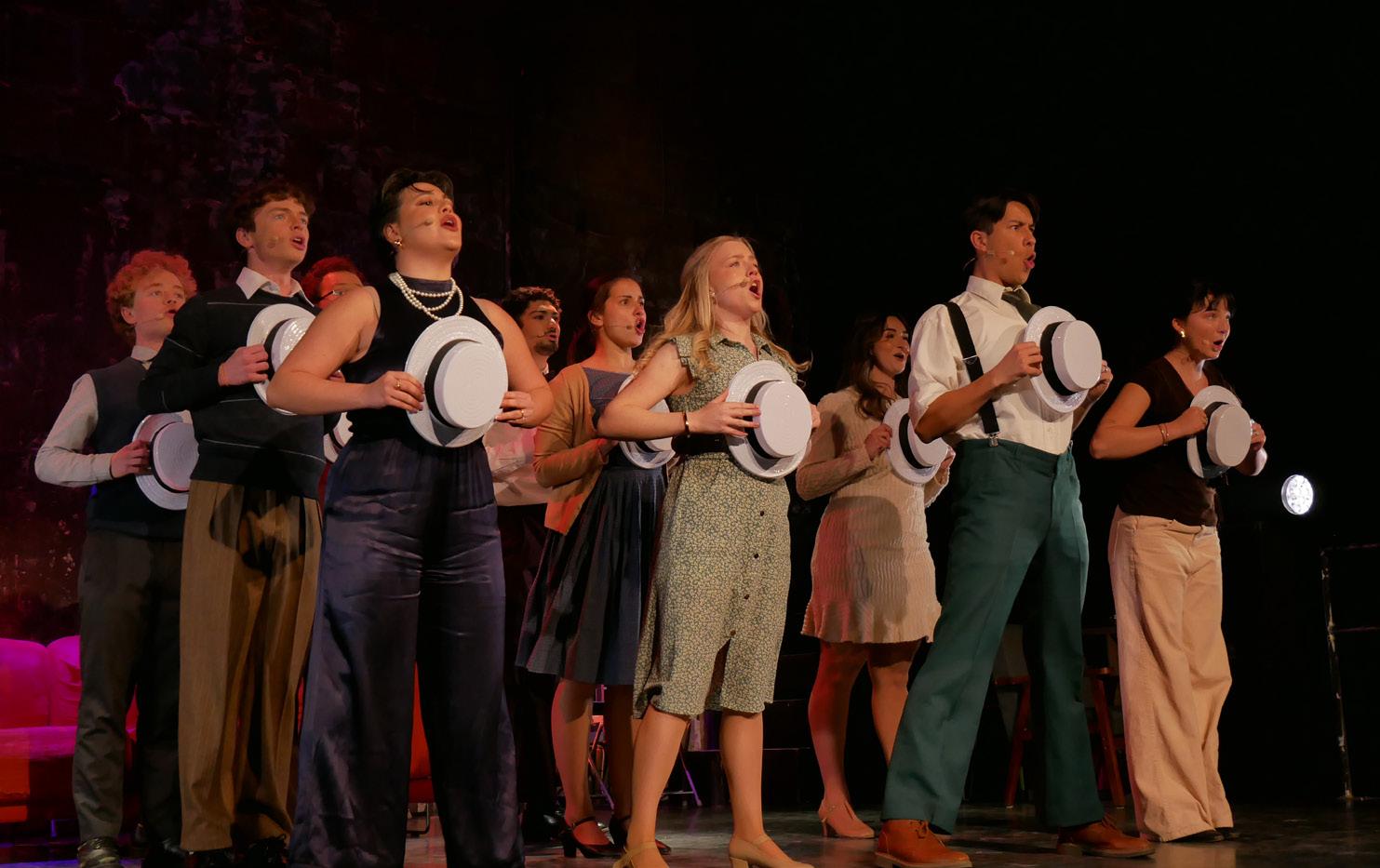
saltine-level flaky Amy, is awarded most likely to be a revolutionary Frenchman, for her astonishing quick-rap solo “Getting Married Today.” In an interview, she told The Tribune that her preparation involved starting at 75 bpm and gradually increasing the tempo until she reached the true pace of the song. She noted the challenge of hitting every beat whilst tracking the chaotic shifts of Amy’s thoughts.
Our final superlative goes to Jeremy Green, U1 Arts, who served as both the Music Director and keyboardist in the band; he is presented with most likely to be an octopus (in another
life). Throughout the two and a half hours of production, he kept a watchful eye on the actors in order to cue the orchestra, all whilst playing the piano. It was remarkable to see the rapport between the musicians and the actors, flawlessly in sync, particularly for a student production.
In an interview with The Tribune, Sam Snyders, Associate Director, describes the production as “alive.” I would agree. From the dedicated cast to the impassioned audience, the room was filled with life, love, and company ”Company played from Jan 25 to Feb 1 at Théâtre Plaza.

‘Universal Language:’ A frostbitten Canadian comedy
f you’re from Winnipeg, you may be familiar with the Rod Peeler bench. For the uninitiated, Rod Peeler is a real estate agent whose distinctive bench ads—plastered with the phrase “I never sleep”—are considered a local legend. When the bench made its cameo appearance in Universal Language, several audience members at the Quebec premiere let out excited gasps of recognition.
“A little narcotic synapse kind of explodes in every Winnipeg brain when they see Rod Peeler,” said director Matthew Rankin in a Q&A after the film.
Details like these are scattered throughout, littering Rankin’s sophomore feature with delightful Canadian in-jokes.
Universal Language is an absurdist fairytale wrapped in ice and snow. The film takes place in a fictional city that blends Winnipeg with Tehran, where two young girls find 500 rials frozen on the sidewalk, embarking on a journey to find an axe to chip it out. Its premise is inspired by beloved Iranian ‘child quest’ films like Where Is the Friend’s House?, which Rankin said he first saw at Cinéma du Parc as a McGill student.
What begins as a simple story, however, quickly evolves into something far more disorienting and surreal, where turkeys are treated like celebrities, Kleenex are a valuable commodity, and characters swap identities. Three disparate
stories become interwoven: As the girls attempt to uncover the money, Massoud leads walking tours around the city, and Matthew returns home from Quebec to visit his mother.
“We think of the film as a little bit like the Salvador Dalí lobster telephone, or you could think of it as a Venn diagram, or you could think of it as a Hawaiian pizza. It’s sort of a blending of spheres, and it emerges out of a confluence of three cinematic languages,” said Rankin, citing the influence of Iranian, Winnipeg, and Quebec cinemas on the film.
It seems surprising that such a whimsical narrative would play out against Winnipeg’s brutalist architecture and frigid climate, but the film treats these elements with great affection. Shooting on 16mm, cinematographer Isabelle Stachtchenko draws viewers into the details of the landscape. The soft grain makes corrugated concrete look like pleated velvet and banal details like a streak of black graffiti on a brick wall or a car exiting a spiral parkade become visually engrossing spectacles. Early in the film, one character establishes that the city is divided into the beige district, the grey district, and the brown district. While the film may poke fun at the city’s muted shades, it also reveals how the more carefully you look, the more idiosyncrasies can be found.
The film’s ensemble is made up of friends and family, who each collaboratively shaped the film in their own ways. “I’m a big believer that you should make films with your friends,” said
In the first scene, a temperamental school teacher (Mani Soleymanlou) reminds his students that he isn’t like other authority figures—He wears an earring! He’s played the electric guitar for them more than once!—establishing a comically earnest tone that is threaded consistently throughout.
The two young girls, Negin (Rojina Esmaeili) and Nazgol (Saba Vahedyousefi), also stand out, both charmingly deadpan and sincere. Their high-stakes quest is absorbing and nostalgic, so I was slightly disappointed that the parallel story of Matthew ended up dominating the narrative.
Played by Rankin himself, Matthew’s storyline introduces an intriguing semiautobiographical element to the film, but his characterization lacks the same compelling, idiosyncratic qualities the young cast members share. At times, the melancholic tone of Matthew’s journey home seems to be in conflict with the rest of the narrative, tonally inhabiting a different world from the children. Although the film’s central theme is convergence, this
shift suggests that generational divides might be more difficult to reconcile. Regardless, Rankin’s blending of disparate elements has created a world that is entirely singular and unique. Through the howling wind and crunching snow, Universal Language bridges impossible-seeming gaps between ideas and places.
UniversalLanguage is in theatres across the country.

Zain Ahmed Staff Writer
In a move that sent shockwaves through the basketball world, the Los Angeles Lakers acquired Luka Dončić from the Dallas Mavericks in exchange for Anthony Davis on Feb. 1. The trade, which emerged seemingly out of nowhere, represents one of the most significant player movements in National Basketball Association (NBA) history and fundamentally alters the league’s power structure.
Behind the scenes, the trade was a masterclass in NBA deal-making. Mavericks General Manager Nico Harrison and Lakers General Manager Rob Pelinka orchestrated the deal with surgical precision and professionalism. Their ability to maintain complete secrecy until the trade’s completion—even keeping heavy hitters like LeBron James in the dark until the final moments—demonstrates how front-office relationships have transcended traditional market rivalries in modern sports franchises like the NBA.
Dallas’s pursuit of Davis indicates a clear prioritization of defensive excellence and organizational culture change. Davis is a five-time All-Defensive player, nine-time NBA All-Star, and two-time Olympic gold medallist. While Dončić’s offensive brilliance is indubitable—the five-time NBA All-Star ranks third in NBA history in career scoring average, behind only Michael Jordan and Wilt Chamberlain—the Mavericks’ concerns about his conditioning and
long-term commitment to physical excellence ultimately drove this decision. It has been speculated that Mavericks brass was motivated to move on from Dončić because of ‘constant conditioning issues.’
At the end of the day, the Lakers have secured a successful future, with this trade representing both immediate impacts and long-term planning. In Dončić, the team is acquiring a generational talent entering his prime who can shoulder the offensive load alongside LeBron James while eventually becoming the face of the franchise. The move ensures the Lakers remain relevant in the post-LeBron era, though it creates immediate questions about their defensive structure without Davis.
Spectators should consider the media’s role in modern basketball, having analyzed the trade in awe. This trade exemplifies the rapidly evolving nature of NBA transactions, pioneered by the way sporting faculties are developing in the social media era. Although there is constant speculation about player movements, this Hollywood deal remained entirely secret from the media’s professionally invasive eye. This secrecy likely contributed to its successful completion, avoiding the public pressure and speculation that has derailed other highprofile trades such as Paul George and Russell Westbrook potentially moving to the Raptors in 2019.
The league-wide implications are glaring to both fans and pundits within the basketball world. The ripple effects of this
trade will be felt throughout the NBA because it raises questions about team building in the modern game. Many have stopped to speculate about whether or not offensive brilliance alone is enough to build around, and how much personality and work ethic factor into player retention. The trade also highlights the growing influence of new ownership groups in reshaping traditional franchise dynamics, as evidenced by the Adelson family’s willingness to trade away the supposed cornerstone of Dallas’ franchise.
Looking ahead, as both teams adjust to their new realities, the success of this trans-
action will be judged not just by on-court performance, but by its impact on sustaining team culture long-term. The Mavericks are taking a gamble on the fact that Davis’ two-way excellence and professional approach will establish a new identity, while the Lakers are rolling the dice on Dončić’s otherworldly offensive talents maintaining their position among the NBA’s elite. The Lakers currently sit in fifth place in the Western Conference, while the Mavs sit in an underwhelming 11th. Both teams hope to reap the rewards of their shiny new toys as the hunt for NBA stardom continues for the rest of the season.
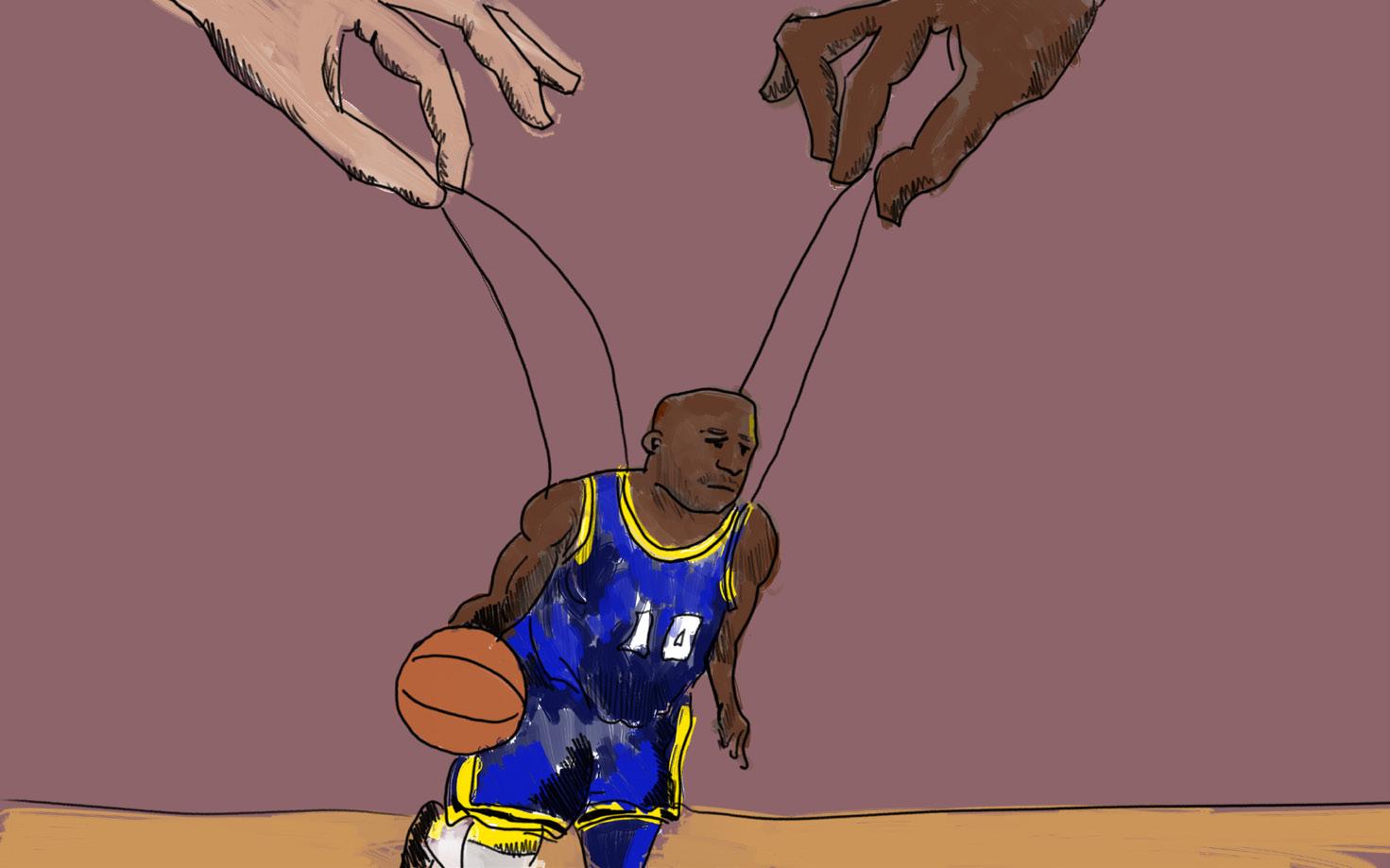
Reuben Noam Staff Writer
Naomi Girma just made history— and her bank account is very, very happy. The 24-year-old U.S. Women’s National Team (USWNT) defender became the first million-pound player in women’s soccer, sealing the record-breaking €1.07 million transfer from San Diego Wave to Chelsea Women on Jan. 26. A seven-figure move in a sport where, until recently, teams were debating whether they could afford charter flights, is no small shift.
This achievement is not just a win for Girma, Chelsea, or women’s soccer bankrollers. In a sport that has historically struggled with diversity, the first player to smash this financial ceiling is a Black woman. Not only does this deal set a new financial benchmark, but it also holds profound cultural and social implications for the posterity of a white-dominated sport.
Especially in countries like the U.S. and England, women’s soccer has been predominantly white and upper-class in recent years. Factors such as the payto-play model in U.S. youth sports have often limited access for underrepresented communities, leading to an insistent white majority. In England, the shift of training facilities to suburban areas has made participation challenging for low-income girls, further contributing to the homoge -
neity of the player base. The phenomenon has also been noted in other league pairs, such as the National Basketball Association (NBA) and the Women’s National Basketball Association (WNBA).
In contrast, men’s soccer hosts many more players from diverse backgrounds at all levels, from Emmanuel Boateng to Neymar. This is due in part to the charity and funding that flows into the sport regularly. The Fédération Internationale de Football Association (FIFA), is one of the wealthiest sports organizations globally. As of the end of 2022, FIFA’s balance sheet totalled approximately $6.8 billion USD, with reserves reaching an unprecedented high of $3.97 billion USD. Nearly all of this revenue comes from and goes back into the men’s game, which allows for diverse developmental pathways and greater accessibility at a grassroots level.
In this context, Girma’s ascent to becoming the first million-pound player in women’s soccer is particularly significant. Her success challenges the existing norms, and her visibility at the highest levels of the sport may inspire young athletes to follow in her footsteps. This landmark deal not only underscores Girma’s exceptional talent but also signifies the growing investment and recognition in women’s soccer.
Girma’s move to Chelsea should (and hopefully will) be a wake-up call for clubs around the world. Investing in women’s soccer is not just equitable—it’s good
business. The level of play is rising, audiences are growing, and, as this transfer proves, top players are becoming assets— ones worth spending big on.
More importantly, this moment should push youth development systems to rethink how they nurture talent. No more forcing kids to pay thousands for elite academy access. No more structuring pathways that make it nearly impossible for working-class or non-white players to succeed. The game should belong to everyone.
Efforts to promote diversity in women’s soccer are gaining momentum. Initiatives like England Football’s “Discover My Talent” campaign seem to be doing more and more to provide opportunities for girls from all socioeconomic backgrounds. However, as always, challenges such as the costs, time commitments, and accessibil -
ity of training facilities persist—but trailblazers such as Girma illustrate that it’s possible to take down these barriers. It is important not to forget Chelsea in all this. Sonia Bompasto’s squad has bagged a world-class defender who will be crucial in their hunt for silverware. But even beyond her impressive story, Girma’s signing makes Chelsea part of history—a club being willing to break records for a defender is always progress worth celebrating.

Alex Hawes Silva Staff Writer
This past weekend, a group of roughly 60 McGill students and McGill Outdoors Club (MOC) staff members headed to Auberge du Lac Priscault for the annual MOC Winter Olympics. Participants boarded a twohour bus ride and braced themselves for a weekend of snow and sweat.
Upon arrival, the students were grouped into six different teams and tasked with creating a group name and chant, creatively ranging from Ketchabasco to MAMASCAN.
After this exciting introduction, the Olympians retreated to their bunk beds to rest up for the competition. On Feb. 1, the first event was a thrilling tournament of snowshoe racing, where participants had to sprint through an obstacle course as fast as possible in snowshoes while having snowballs hurled at them. Between the chanting, tripping, and heavy snow, the race was an intense start to the day. Shortly afterward, the groups were sent to start building their quinzees—shelters made of a hollowed-out pile of snow. After over an hour of digging and packing down snow, participants left for lunch while the quinzees froze over.
Next on the agenda was Ice Man’s Revenge, an infamous take on tug-ofwar, where participants are strapped into harnesses and tied to an opponent with a
long rope. The aim is for opponents to use ice axes to climb away from each other on their stomachs and to pull the competitor across the boundary: A gruelling game that uses every ounce of strength participants have.
Back at the quinzees, participants began digging the shelters out and polishing them into some impressive pieces of architecture. One quinzee was furnished with an ice fridge, others had non-stop Frank Sinatra playing for ambience. The night ended with some star-gazing and camp games, with competitors putting aside the competition and sharing some laughs and snacks.
MOC President Zosia Stevenson, U3 Arts, and competitor Maya Cordano, U1 Arts, spoke on their experiences from the weekend.
“Seeing a bunch of adults letting their inner child out and having fun outside was definitely the main highlight for me,” Stevenson said.
“It felt like being a kid again—running around in the snow—only better, since there was no curfew,” Cordano added.
In addition to the events, participants were also assigned to make and serve one meal during the trip. Competitors helped prepare wraps, burrito bowls, waffles, and much more. Chatting and listening to music while cooking was another way participants bonded and came together over the weekend.
The final competition of the Olym -
pics was a sled wheelbarrow relay race, where one participant had to plant their hands on a sled while being pushed in wheelbarrow position by a team member and weaved through an obstacle course of sleds and snowshoes. Competitors persevered past frozen fingers and toes to give everything for the finale.
After a hectic and entertaining last event, the Olympians packed up their cabins while they awaited the final results. Tensions were high in the final ceremony and teams gave their all for one last chant. The team It’s Always Sunny in Plaiyadelphia took first place, with The Humble Horseshoe Hares and The Conservation of the Wenguins following closely behind. Team members happily received handmade trophies that resembled the MOC house.

dents to shake off the stress of midterms and build connections with other outdoor enthusiasts that they would not otherwise have had the chance to meet.
This fun-filled weekend would not have been possible without the work of the MOC executives and the amazing hosts at Auberge du Lac Priscault. They created the perfect environment for stu -
“Going to the Winter Olympics was one of my defining McGill experiences,” participant Sam Rudin, U1Arts, shared in a written statement with The Tribune “You had the opportunity to meet people with interesting experiences and to develop a bond centred around a core experience. It’s something that I will carry forward with me and cherish.”
Sofia Vidinovski
Contributor
This past Saturday, Feb. 8, Redbirds hockey won 4-2 against the Lakehead Thunderwolves in what one could call a brawl masked as a university hockey game. The intense aggression and rigour from the Thunderwolves were counteracted by the Redbirds, leading them to a predictable but entertaining victory.
Centre Charles Boutin, U1 Management, scored an impressive first goal 10 minutes into the first period, sneaking the puck from the goalie and taking the opportunity of a semi-open net. Shortly after, forward Brandon Frattaroli, U3 Arts, scored in the 12th minute, followed by another goal from centre Xavier Fortin, U2 Arts, only 30 seconds later. The Redbirds ended the first period with a 3-0 lead.
The second period opened with some great stickhandling from the players. As the Thunderwolves began their fight for a goal, the Redbirds knew they had to increase their stamina.
The first penalty of the game was handed to the Thunderbirds, this marked the beginning of many penalties to come. Luckily, this powerplay proved beneficial for the Redbirds, as Frattaroli scored his second goal of the game. The Redbirds’ sizable lead overwhelmed the Thunderbirds, and fights began to break out between the two teams, leading to several roughing penalties. The aggression
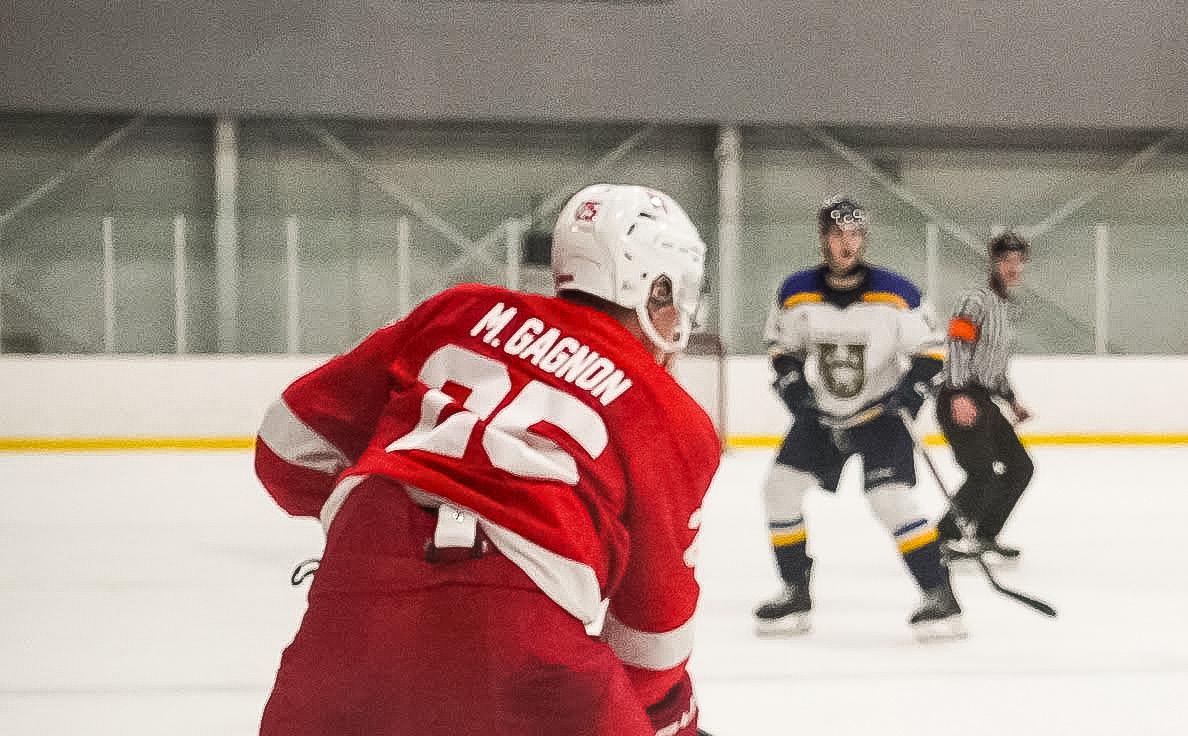
also felt content with the team’s performance Saturday night.
“It’s a great win,” he said. “I thought the first two periods were outstanding and you can really see the potential in the team, and it’s a big win because that clinched the playoff spot for us.”
The Ontario University Athletics East first round of playoffs for the Redbirds begins Wednesday, Feb. 19. The location and timing of the game are to be decided.
The Redbirds will take on Ontario Tech Ridgebacks in Oshawa, Ontario on Feb. 15 at 7 p.m.. The Ridgebacks are currently ranked above McGill in the Ontario University Athletics East.
The game saw 15 penalties between both teams, starting in the second period. (Bruno Cotler / The Tribune) Quotable:
became useful for the Thunderbirds, leading them to score their first goal of the game 16 minutes into the second period. However, the Redbirds continued to carry their lead into the third period, ending this one at 4-1.
The Redbirds began the period with a penalty, which was shortly followed by another Thunderwolves penalty. The Thunderwolves scored their second goal five minutes into the third period. Penalties were handed out left and right as players continued to find themselves in altercations. The audience even pitched in to alert the referees when they noticed a Thunderwolves player slashing one of the Redbirds. While the Thunder-
wolves put up a good fight, the Redbirds won the game 4-2.
Frattaroli commented on the Thunderwolves’ rigour in the third period.
“The team in the third period made a good push,” he said. “Our penalty kill was outstanding. We found a way to fight the penalties and ended up winning.”
Left Wing Stephane Huard, U2 Arts, felt confident with his team’s performance despite the challenges in the third period.
“[I feel] pretty good,” he said. “We are getting back to our game, so I am pretty happy with that.”
Redbirds Head Coach David Urquhart,
“We still have two games to go, so our goal is to have home [games] in the first round, and if we can take business on our end in the next two games we will get that.” — Coach Urquhart
Moment of the game:
One particularly notable moment of the game was the 360 flip save made by the team’s goalie, #31 Alexis Shank, U4 Arts. The goalie was able to flip around and save a fast-flying puck coming his way. The act blew the crowd away, even some players looked surprised to see such an impressive save!

Understanding the role of alcohol in severe allergic reactions
New study sheds light on how different triggers affect adult anap hylaxis
Daniel Pyo Staff Writer
Anaphylaxis is a life-threatening allergic reaction that occurs when the immune system overreacts to a trigger, such as food, drugs, or insect stings. Symptoms can escalate quickly, leading to difficulty breathing, a drop in blood pressure, and swelling of the throat, requiring immediate medical intervention. For people with severe allergies, rapid access to treatment can mean the difference between life and death.
A recent study has shed light on a concerning factor that can worsen allergic reactions: Alcohol. A team of researchers at McGill and other Canadian universities found that people with nut allergies who consumed alcohol experienced more severe symptoms. Alcohol can act as a cofactor, meaning it enhances the body’s allergic response.
Roy Khalaf, a fourth-year medical student at McGill, worked on this study under the mentorship of Dr. Moshe BenShoshan at the Research Institute of the McGill University Health Centre’s Infectious Diseases and Immunity in Global Health Program. Khalaf analyzed over 1,100 adult cases of anaphylaxis across Canada to examine the severity of reactions triggered by different allergens.
Food-induced anaphylaxis was the
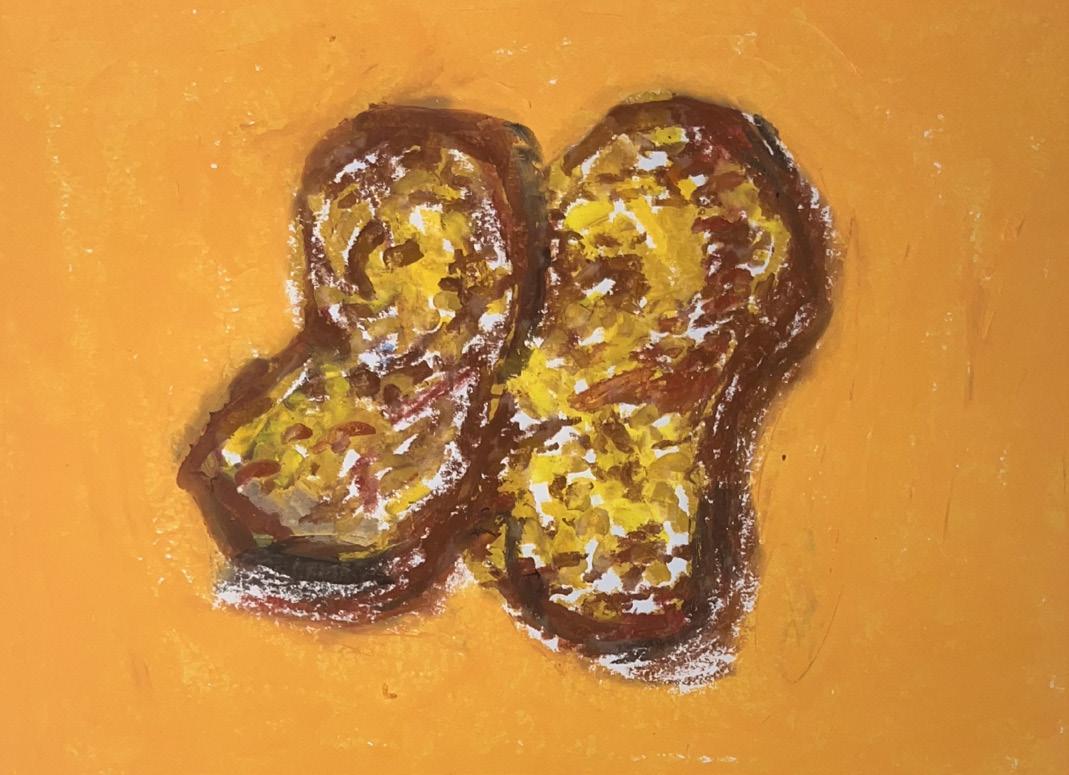
most common trigger, responsible for over 50 per cent of emergency department visits related to severe allergic reactions. Among food-related cases, peanuts and tree nuts emerged as the most frequent culprits, with tree nuts linked to particularly severe symptoms.
Tree nut-induced anaphylaxis stood out due to its high prevalence of throat tightness, a symptom that can quickly escalate into life-threatening airway obstruction. The study found that 75 per cent of tree nut allergy cases involved throat tightness.
Moreover, compared to other triggers of allergy symptoms, nut-induced anaphylaxis was among the most severe, with patients significant-
by John Valerio
ly more likely to require epinephrine administration in a hospital setting. Epinephrine—also known as adrenaline—is a lifesaving treatment that can reverse anaphylaxis symptoms.
One of the study’s most striking findings was the strong association between alcohol consumption and severe nuttriggered anaphylaxis, reinforcing the need for individuals with nut allergies to be cautious when consuming alcoholic beverages. Alcohol also lowers the threshold for severe reactions, making early intervention with epinephrine even more critical.
Alcohol may exacerbate allergic reactions by worsening hypotension—low blood pressure—a critical aspect of anaphylaxis that can lead to shock. Because alcohol itself can cause a drop in blood pressure, it can intensify the already dangerous effects of anaphylaxis, raising the risk of cardiovascular collapse.
Additionally, some alcoholic drinks, particularly nut-flavoured liquors like Amaretto and Galliano, may contain traces of allergens— whether from natural ingredients or artificial flavourings—posing an additional risk to those with nut allergies.
“When you drink alcohol, just make sure you read what is labelled and what this alcohol drink has, because it could have some nut flavours, and you could have an anaphylactic reaction, and that is a life-threatening reaction,” Khalaf said in an interview with The Tribune, warning about the hidden dangers in some liquors.
Despite epinephrine being the first-line treatment for anaphylaxis, many patients fail to use it when needed. The study revealed that only 30 per cent of individuals experiencing tree nutinduced anaphylaxis used epinephrine before reaching the hospital, compared to over 50 per cent of peanut allergy sufferers.
This suggests that individuals with tree nut allergies may be less aware of the severity of their reactions or less likely to carry their autoinjectors. Increasing awareness and accessibility of epinephrine could be crucial in preventing fatalities.
“We need to make the EpiPen more accessible. We need to educate patients on the importance of using EpiPens and epinephrine if they experience an anaphylactic allergic reaction,” Khalaf emphasized.
With food allergies on the rise, proactive measures are necessary to reduce preventable deaths. Improved education, greater access to epinephrine, and stronger public regulations regarding food and beverage labelling can help improve outcomes for those living with severe allergies.
COMICS design@thetribune.ca


K. Coco Zhang Science & Technology Editor
On Feb. 4, McGill’s Desautels Faculty of Management organized a panel discussion titled Black Women’s Entrepreneurship: Research vs. Reality. The event’s discussion tackled a striking statistic: Only two per cent of Canadian businesses are Black-owned, and fewer than 30 per cent of these are led by women.
Bringing together prominent figures from the Black entrepreneurship ecosystem, the panel explored the challenges and opportunities faced by Black entrepreneurs aspiring to build successful businesses. The discussion highlighted two major barriers—restricted networks and limited access to capital—while showcasing the significant strides that have been made in addressing them.
Access to capital continues to be one of the greatest obstacles facing Black entrepreneurs. Lise Birikundavyi, co-founder and managing partner at BKR Capital, Canada’s first venture capital fund focused on Black-led tech companies, emphasized the critical role of funding in business success.
“Google didn’t grow to its size without significant investment. The same goes for Facebook. And Uber is a perfect case study of how continuous financial backing fuels expansion,” Birikundavyi noted.
Access to influential networks is equally vital. Entrepreneurs need direct connections to key industry players who can open doors to corporate contracts and growth opportunities.
“When we connect a company to a corporation that can provide large-scale contracts, that type of network allows the company to grow exponentially,” Birikundavyi explained.
Despite these challenges, Black-led businesses are gaining traction. Companies like Calendly and Esusu—both now valued in the billions—are proof of this progress. Calendly, a scheduling automation platform, grew from a startup to a $3 billion USD enterprise in under a decade. Similarly, Esusu, a financial technology company, achieved $25.3M USD in revenue in 2024, up from $20.7M USD the previous year.
“There’s a lot happening, and we are seeing companies thrive,” Birikundavyi said, reflecting on the positive shift in the ecosystem.
Indira Moudi, CEO of Viandes Lafrance, shared her personal journey of business acquisition.
“When I decided to acquire my company, I never asked myself, ‘How much was it?’” Moudi recalled. “I knew that by presenting a strong business case, I would secure the funding. It’s about finding the right partners, crafting the right strategy, and having the courage to pursue it.”
Moudi’s story underscores the growing confidence and opportunities within Black entrepre-
neurship. She believes that the gap between Black and white entrepreneurs is narrowing, thanks to greater access to networks, capital, and strategic partnerships.
“We’re discovering incredible talent that the broader ecosystem often overlooks,” Birikundavyi said. “Our goal is to find the best Black founders and showcase what others have missed.”

As of 2023, there were approximately 66,880 Black-owned businesses in Canada.
However, Birikundavyi stressed that BKR Capital is only the beginning. She hopes to see an increase in Black-led funding and encourages mainstream venture capital firms to diversify their investments and support Black communities.
Moudi shared her perspective on how to navigate the challenges of stereotyping and bias with confidence.
“When you enter a business meeting, it’s not about your gender or the colour of your skin; it’s about the objective you’re working toward. Of course, you’ll encounter people who treat you a certain way based on those factors, but that’s secondary to the mission at hand,” Moudi said. “I’ve had moments where I’ve had to shut out the noise, stay focused on my goal, and push past what
doesn’t serve me. It’s not that we should ignore societal issues, but in business, you have to navigate around those challenges and keep moving forward.”
She encouraged others to embrace their identity and refuse to let setbacks define their path forward. For Moudi, success isn’t just about overcoming obstacles: It’s about thriving in spite of them.
“The key is to use your resilience and strength to push through,” Moudi noted.
Looking ahead, fostering Black entrepreneurship requires systemic change. Creating a more inclusive and supportive ecosystem ensures that all entrepreneurs, regardless of background, have equal access to opportunities.
Shane Laptiste celebrates history and future of Black architect ure McGill’s Black History Month Keynote reflects on equity in building and design
Ella Paulin Managing Editor
McGill’s official Black History Month programming kicked off this Feb. 6 with their Black History Month Opening Ceremony and Keynote, featuring architect Shane Laptiste as the keynote speaker. Laptiste, who holds both a Bachelor’s and Master’s degree in Architecture from McGill, spoke on the importance of reimagining architecture to centre Black voices and create inclusive spaces for Black communities in contemporary architecture.
Lynda Bulimo, an Equity Education Advisor at McGill and host of the ceremony, delivered the opening remarks.
“Though we celebrate Black History Month institutionally for the ninth year, we know that Black people have long been here, celebrating, resisting, organizing and innovating in so many ways,” Bulimo said. “I want to credit and thank all the Black people who came before us and who made way for this present moment.”
She introduced Robert Spade, assistant professor at the Schulich School of Music and Senior Cultural Advisor at McGill, who officially opened the ceremony with a speech emphasizing tolerance and curiosity.
“The world is mysterious. It’s a wondrous place. If somebody has a way that you don’t understand, it’s okay,” Spade said. “When I was 18, you see, I knew everything. Now that I’m a little older, I feel like I know less and less.”
Spade closed his introduction with a song before passing the microphone to Tynan Jarrett, Director of Equity and Diversity in the Office of the Provost and Dami Bali, President of the McGill chapter of the National Society of Black Engineers. After Bali, Claire Mabia, Black Affairs Commissioner of the Student Society of McGill University, spoke about her work overseeing programs like the Black Equity Fund. Finally, David Theodore, Director of McGill’s Peter Guo-hua Fu School of Architecture, introduced the keynote speaker.
Laptiste began his keynote with a story about his great-grandmother, who came to Montreal in 1922 from Grenada.
“She came to Montreal as a domestic worker, leaving behind my one-yearold grandfather, and she spent nearly five decades in Montreal living in a range of housing, mostly adjacent to the St. Antoine neighbourhood, now known as Little Burgundy,” Laptiste said in his talk. “Through mostly unwritten rules, it was also the one area that, as a single Black woman, she would have been able to obtain housing in Montreal.”
This personal history drew Laptiste’s attention to the ways Black communities have been systematically pushed to the margins in North American cities through discriminatory housing practices, both legally enforced and informal.
His interest in architecture began young, and he remained committed to pursuing it despite the barriers he faced in his education.
“After seeing a Black architect on TV, I was inspired to become an architect and enrolled at McGill School of Architecture,” Laptiste said. “Being one of the few Black students, I encountered a certain invisibility of Black agency and the shaping of space, as well as a lack of recognition of the architecture of Black cultures and communities.”
Since graduating from McGill, Laptiste has co-founded the Toronto-based architecture firm Studio of Contemporary Architecture (SOCA) with Tura Cousins Wilson. Among his ongoing projects, Laptiste described a public fountain in Toronto designed to honour Black residents of 19th-century Toronto, whose names they had found in old city directory books, and an interpretive centre for the Oro African Methodist Episcopal Church built in Oro, Ontario in 1849 by Black veterans of the War of 1812.
Laptiste is also in the process of designing a memorial dedicated to Samuel Adams, a Black ironworker who came to Canada through the Underground
Railroad and invented a popular tool used to excavate gravel from riverbeds for use in reinforced concrete. The memorial incorporates stones from Adams’ original house, repurposing them to create a space for reflection and learning.
In addition to these projects, Laptiste runs workshops, collaborates with researchers studying Black spaces and histories, and engages in discussions with communities about how best to support their needs through architectural projects.
“There’s the balance of social, aesthetic, functional, economic, cultural, and environmental considerations that are key to the process, and it’s impossible for that to be done from a singular viewpoint,” Laptiste said.

Tamiyana Roemer Staff Writer
Second only to, “It’s not you, it’s me,” the phrase “I don’t know. You choose,” is the most unromantic thing you can say to your Valentine. If your Valentine’s Day plans lean more towards concepts than concrete visions, it’s time to get organized—and fast. Luckily for you, I’ve already made my reservations. Roses are red, violets are blue, I’d like to make planning easier for you. Here’s my list, or rather, my love letter, to Montreal’s most romantic restaurants and bars.
Nili
With its vibrant red lighting and playful decor, Nili is the epitome of cool. Within its four eclectically-decorated walls, the restaurant offers the perfect atmosphere for an intimate meal. Its menu, featuring a mix of French and Moroccan-inspired dishes, is simple but undeniably delicious. Start with the refreshing cucumber and mint hummus, followed by the rich, flaky chicken pastilla. For dessert, indulge in msemen, a flat Moroccan pancake served with orange blossom sauce and topped with rosebuds.
Eliza Lee News Editor
WBuvette Pastek
Located in the heart of Old Port, Buvette Pastek is a candle-lit restaurant that invites romance all year long. They have designed a $75 CAD-service Valentine’s Day menu available exclusively on Feb. 14 and 15. The service begins with an amuse-bouche of focaccia with red wine butter. There are three appetizer options as well as three main course options, followed by a cheese platter, and finally, a chocolate and strawberry tiramisu for dessert. Though more expensive than the other restaurants on this list, Buvette Pastek promises a memorable night.
Bar St-Denis
Bar St-Denis might be one of Montreal’s most underrated dining spots. Tucked away on Rue St-Denis near Jean-Talon Market, the restaurant blends an unassuming bar aesthetic with seriously impressive cooking. Bold and unexpected dishes, like fresh scallops with bergamot and rice pudding with elderberry and olive oil, add to its charm. Bar St-Denis proves that a restaurant can be both laid-back and one of the city’s best-kept culinary secrets.
Bars
Big in Japan
Once you pull back the dramatic curtains
with a Stranger
concealing this speakeasy’s entrance, you’ll immediately notice all the cozied-up couples. This chic, lavish spot plays its music just loud enough to give every patron the perfect excuse to lean into their date. The dim lighting casts a glow that makes every moment feel cinematic, while the air is filled with the gentle clink of glasses and soft murmur of conversation. A night at Big in Japan is a dressed-up affair, with servers in crisp uniforms with black ties and jazz floating through the room. Best of all, cocktails like their espresso martini and sake sour are as perfectly crafted as the atmosphere.
Bar Suzanne

For a more laid-back night, Bar Suzanne is an ideal spot. With dim, candle-lit tables surrounded by lush greenery, the vibe is relaxed, yet refined. Not only can you enjoy a drink with your date, but the bar menu features the perfect mix of small late-night bites, including crispy fried chicken and their popular dumpling menu. Featuring a warm, unpretentious atmosphere, Bar Suzanne offers you a chance to enjoy a casual yet intimate and stylish night out with your date
If you’re looking to impress your date with a romantic taste of vintage opulence, make a reservation at Kabinet. Inspired by 1970s Paris, the restaurant’s neoclassical interior design touts rich colours, velvet accents, and even a crystal chandelier. The atmosphere is undeniably romantic, with plush seating and soft lighting, perfect for intimate conversations. While Kabinet pays homage to traditional cocktail menus with classics like the pisco sour or the Pimm’s cup, it offers delightful surprises like a tiramisu martini.
hen you picture modern matchmaking services, you might be inclined to imagine social apps that run algorithms at lightning speed to assess the compatibility of two candidates, offering a suitable pairing in just a few seconds.
Dinner with a Stranger McGill takes a different approach to pairing people up: Interested students fill out the club’s monthly questionnaire of personality-based questions. A small team then scrolls through a Google spreadsheet filled with people’s responses, making matches by hand based on students’ similarities and connecting the pair over email.
“It’s very time-consuming,” Stephanie Sartori, U2 Science and Dinner with a Stranger co-president, told The Tribune
“But once you get in the flow of matching people, I feel like you can get it done pretty quickly,” Erika Kan, U2 Arts & Science and the club’s other co-president, added. “It’s fun because when you find people that are a perfect match, it’s like a rush of adrenaline.”
Sartori and Kan are the co-founders of Dinner with a Stranger McGill: A group dedicated to pairing interested students in the hopes of building lasting friendships. Although some students use the club as a dating service, the co-presidents emphasized that the focus of the club is on fostering community rather than setting up romantic rela-

tionships. In addition to match-making, the club also aims to host social events open to all students—such as their upcoming Galentine’s karaoke night on Feb. 15.
Sartori and Kan explained that the concept behind the club came from Sartori’s sister, who launched a group bearing the same name at the University of Glasgow. Sartori and Kan started their own version of the club in the summer of 2024 after recognizing the difficulties they faced in meeting new people once they were no longer first-years. As international student Buddy Program mentors, hearing from many other students about the challenges of making friends also inspired
them to start the club.
“I feel like I’ve made all of my friends during frosh, and since then, I’m still friends with them, or I’m friends with people who I’ve met through connections,” Kan said. “I haven’t really met new people organically.”
“The lecture room is not an inviting place to talk to random people,” Sartori added.
For Sartori, the cold weather poses an added challenge to socializing, particularly because it means students can no longer meet up outside on campus.
“With winter and the cold and dark vibe of Montreal, [...] I feel like you can feel that
there’s a disconnect, that people aren’t as tight-knit as they are during the fall semester,” Sartori said.
In addition to individual pairings, Dinner with a Stranger offers the option of friend group matches, where multiple people can be matched with another group.
“It’s a pretty popular option. I think it’s a little intimidating to sign up as an individual to just meet a bunch of random people,” Kan said. “A lot of people feel more comfortable signing up with their friends to meet another group of friends.”
Taimaa Bachi, U1 Engineering, and Oksana Pustova, U1 Science, are among the students who have tried the group matching option. They explained that Bachi completed a Dinner with a Stranger questionnaire on behalf of their friend group for a chance to expand their social circle.
“At first it was a little awkward because, like, we didn’t even know what they looked like and we just decided on some random restaurant [to meet up],” Pustova said. “Once we got to talking [...] five minutes in, I’d say that was very chill.”
Bachi and Pustova also echoed the value of the club as a way to make friends, noting that they hoped to try Dinner with a Stranger again in the future.
“This is the one time where we’re surrounded with so many people our age, and it’s still so hard to reach out to people,” Bachi said. “You know [your matches] also want to make friends, and you know they’re there because they want to talk to someone else. So I think it’s a really cool opportunity.”
Bianca Tri Staff Writer
Swab the World is a non-profit organization that helps patients locate STEM cell donors easily and quickly. They provide a platform for individuals seeking matches to launch an effective recruitment campaign as well as a space for them to “connect, share, love, and grieve,” according to their website.
Co-President Matthew Homa, an MDCM Candidate at McGill, wrote to The Tribune to discuss the club’s activities. Homa explained how the chapter, which is under the Medical Students Society, was founded and why he joined the organization.
“Our founder, Mai Duong, was diagnosed with acute myeloid leukemia in 2013, and after beating it once and having it return, she learned that a stem cell transplant was the only treatment that could save her life,” Homa wrote. “However, recipients are more likely to match with someone of their ethnicity, and the lack of diversity in our current registry made it virtually impossible for her to find a match.”
He went on to write that Duong rallied the Montreal Vietnamese community to find her match. After she secured a donor, Duong made it her mission to raise awareness about the lack of diversity in donor pools, leading her to start Swab the World. In 2018, she

co-founded the organization with Christiane Rochon, and in 2021, McGill’s chapter was launched by Chloe Gordon and Owen Luo.
“At McGill, our passionate club of 40 Swab ambassadors continue [Duong’s] mission on the local level, helping raise awareness about the need for stem cell donors and the inequality in finding a donor while helping students sign up for the donor registry.”
Homa also touched on the challenges the chapter has faced, writing about the difficulty of reaching ethnically diverse students.
“One of the biggest growing pains has definitely been reaching out to the broadest audience possible,” he wrote. “It’s easy to fall into a niche, advertising in the same buildings on campus or collaborating with the same clubs because that’s familiar to us. However, we would then be actively disadvantaging all of the communities that need donors whom we’re not working with! So, we’re always trying new things, working with new clubs, and sharing our message with the broader community.”
One way they do this is by collaborating with culture clubs to reach diverse students. On Jan. 31, the chapter hosted an intercultural food fair with the McGill Vietnamese Students Association and the McGill University Filipino Asian Students Association. The culture clubs sold treats—with 50 cents of each sale going to Swab the World, and the Swab
ambassadors offered on-site swabbing kits. The chapter also frequently hosts swab booths that allow McGill students to submit their saliva samples for registration. These DNA samples, after being examined for particular characteristics, are used to match donors with patients.
The chapter has several events coming up that Homa wanted to bring attention to. First, on Feb. 14, they will have a swab booth at the Black Student Network’s Black Beauty Day. The next day, Feb. 15, they will host a swab booth at the DKE house before the frat’s party. Finally, on Feb. 22, they are tabling and hosting a swab booth at the Coda Foundation’s Coda Gala. Coda is a student-led non-profit raising money for hospital cancer care.
Looking ahead, Homa wrote that their chapter will have a booth at the Universities Allied for Essential Medicines’s North American conference from Mar. 21 to 23 to discuss the racial barriers to transplant access.
For anyone unavailable to attend events in person, it’s possible to swab from home.
“While we’d love to see you join our events and swab to join
the registry, you can register from home! Just look up Swab the World, visit our website, and register to donate. A kit will get sent to your house, and you can swab your cheek at a time that works for you! Stem cell transplants are often the last treatment option for leukemia, lymphoma, and otherw patients with hematologic conditions, so your 5 minutes signing up could save a life,” Homa wrote.
Find Swab the World on Instagram @swabtheworld_mcgill.

68
What does Cupid have in store for you this Friday?
Simona Culotta Contributor
Unsure how your Valentine’s Day will unfold? Luckily for you, we do! Check out your horoscope to see if love is in the stars for you.
Aries (March 21 – April 19): Your fiery passion has you convinced you’re the one for someone special—but don’t let excitement turn into delusion. You might think they’re fashionably late when, in reality, you’ve been ghosted. Channel your energy into something productive—the gym is calling, and those chocolates don’t stand a chance!
Taurus (April 20 – May 20): Forget romance—this Valentine’s Day is all about the platonic relationships in your life! You may be a little disappointed at first, but when your friends surprise you with sweets, teddy bears, balloons, and a movie night, romance will be the last thing on your mind.
Gemini (May 21 – June 21): Why choose just one Valentine when the stars align for multiple? This Feb. 14, you’ll find yourself juggling more than one admirer, unable to turn down any offers. With breakfast, lunch, dinner, and even a late-night rendezvous, you’ll make the most of your romantic prospects and, of course, enjoy plenty of free meals along the way.
Cancer (June 22 – July 22): Lucky Cancers, your Valentine will be completely smitten with your nurturing and caring personality. They’ll plan the entire day, choosing the perfect gifts, and making sure everything is just right as a way to express their admiration for you. This special someone isn’t a temporary fling, and this day could stand as a mark of your love if you play your cards wisely.
Leo (July 23 – Aug. 22): This Valentine’s Day, opt for a stress-free celebration and skip the pressure of planning the perfect date. Instead, treat yourself to the ultimate holiday package—candles, sweets, and plush gifts—all yours to enjoy. By spending some quality time with yourself, you’ll bask in the peaceful luxury of self-love and indulgence.
Virgo (Aug. 23 – Sept. 22): Unlike Cancers, who expect their Valentine to plan the day, your perfectionist nature drives you to create the perfect celebration. From décor to details, your efforts will make the occasion truly special—so when your Valentine arrives, they’ll say the phrase you love to hear: “It’s perfect.”
Libra (Sept. 23 – Oct. 23): No date scheduled on the 14th? No problem! With your charm and charisma, you’ll woo someone on the spot and claim them as your Valentine. Perhaps a stroll down Saint-Laurent or a spontaneous night out at the bars is
in the cards for you?
Scorpio (Oct. 24 – Nov. 21): Flattered yet conflicted, you’ll be overwhelmed by a classic Valentine’s predicament: What to do when two people declare their undying love for you. It’s a tough decision to make. But at least, unlike Aries, you’re not the one getting your heart broken.

Did you know that cupid, the paragon of love, originated in Greek mythology as the son of Aphrodite? ( Lily Ashton/ The Tribune )
Sagittarius (Nov. 22 – Dec. 21): Your constant need for adventure will take you and your Valentine to the ice skating rink! After all, what’s more romantic than stumbling into each other’s arms? Just be careful! Red may be the colour of love, but let’s stick to roses and hearts, not stitches and an ambulance ride…
Capricorn (Dec. 22 – Jan. 19): You will spend this day helping friends find a date instead of securing one for yourself. How delightful of you, Capricorn, you make such a great friend. Hopefully, the satisfaction of a job well done is more than enough.
Aquarius (Jan. 20 – Feb. 18): You may be expecting to spend Valentine’s Day alone as the independent and busy person that you are. However, fate will intervene; perhaps a mysterious letter will invite you to a rooftop meeting. Wonder who it could be?
Pisces (Feb. 19 – March 20): Your emotions will run deep on Valentine’s Day, prompting a sip of Pinot Grigio with every happy couple in sight. As the glasses add up, so will your courage to call that ex you never quite got over. The Tribune recommends putting your phone on ‘Do Not Disturb,’ on the 14th but hey, love (or wine) works in mysterious ways. (P.S. avoid drinks and bars this Friday).